unique electronic MS3398 Bluetooth Barcode Reader User Manual MS3390 UserManual en V1 1 11
Shenzhen Unique Electronic Int'l Limited Bluetooth Barcode Reader MS3390 UserManual en V1 1 11
User manual
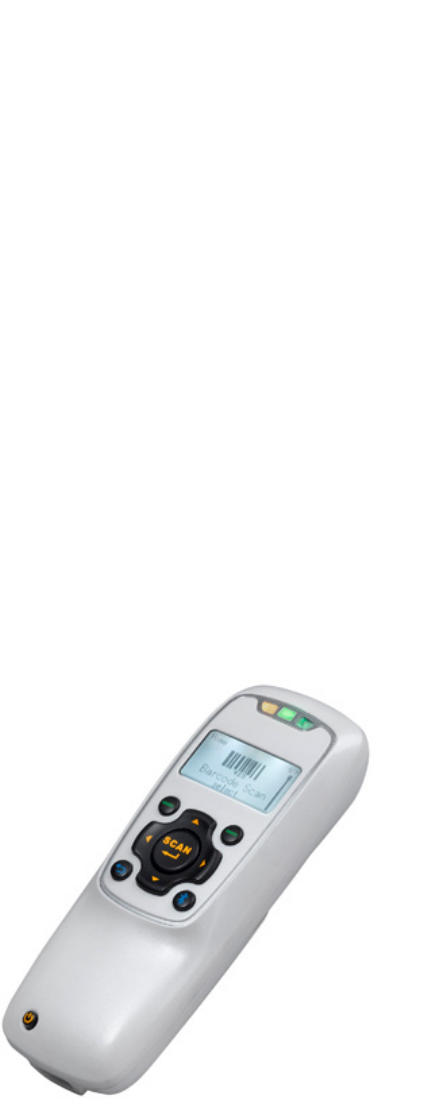
MS3398 Mobile Scanner
User Manual
Version: MS3398_UM_EN_V1.1.11

i
Notice
Before operating this mobile scanner, please make sure you carefully read the following information to
ensure that your scanner is able to perform at the level for which it is designed.
1. All software, including firmware, furnished to the user is on a licensed basis.
2. The right is reserved to make changes to any software or product to improve reliability, function, or
design.
3. The contents of this manual are subject to change without notice.
4. The manufacturer assumes no responsibility for any loss or claims by third parties which may arise
from the use of this manual.
5. Do not throw or drop the scanner or otherwise subject it to strong impact, which can damage the
scanner, interrupt program execution, corrupt memory contents, or otherwise interfere with proper
operation.
6. A standard packing includes a mobile scanner, a USB cable and a CD (containing software and
electrical manuals). Accessory includes a Bluetooth USB adapter BA2118 which supports reliable
wireless data transmission and an AC/DC adaptor for battery charge.
7. Please charge the battery before the first time of use.
8. The term “scanner” as used in this manual denotes the MS3398 mobile scanner unless otherwise
noted.

ii
Contents
Notice..............................................................................................................................................................i
1 Specifications ............................................................................................................................................ 1
1-1 Technical specifications ............................................................................................................... 1
1-2 Default settings for each barcode............................................................................................... 3
1-3 Decode zone..................................................................................................................................4
1-4 Dimensions .................................................................................................................................... 5
1-5 Parts of the scanner...................................................................................................................... 6
1-6 Parts of the Bluetooth USB adapter BA2118............................................................................ 7
1-7 Keys, actions and features .......................................................................................................... 8
2 Introduction to installation........................................................................................................................ 9
2-1 Installing a USB HID keyboard wired scanner.......................................................................... 9
2-2 Installing a USB virtual COM wired scanner ............................................................................. 9
2-3 Attaching the neck/wrist strap ................................................................................................... 10
2-4 Replacing the Lithium-ion battery .............................................................................................10
3 Getting started......................................................................................................................................... 11
3-1 Power on/off scanner.................................................................................................................. 11
3-2 Charge battery............................................................................................................................. 11
3-3 Enter/Exit sleep mode ................................................................................................................11
3-4 Power on/off Bluetooth ............................................................................................................... 11
4 Introduction to LCD display ................................................................................................................... 13
4-1 LCD display icons ....................................................................................................................... 13
4-2 LCD display menu....................................................................................................................... 14
5 Operations of the scanner ..................................................................................................................... 16
5-1 Scan .............................................................................................................................................. 16
5-2 Data Transfer............................................................................................................................... 18
5-3 System Setting - Bluetooth ........................................................................................................20
5-3-1 Bluetooth functionalities.................................................................................................. 20
5-3-2 Configure Bluetooth HID keyboard profile communication ....................................... 21
5-3-3 Configure Bluetooth SPP slave profile communication ............................................. 24
5-3-4 Configure Bluetooth SPP master profile communication ..........................................26
5-3-5 Configure Bluetooth USB adapter BA2118 .................................................................27
5-3-6 Configure the profile of BA2118 ....................................................................................28
5-4 System Setting - General........................................................................................................... 28
5-5 System Information ..................................................................................................................... 29
6 Barcode programming instructions ...................................................................................................... 31
Programming instruction................................................................................................................... 31
UPC-A.................................................................................................................................................. 32
UPC-E.................................................................................................................................................. 33
iii
EAN-13 ................................................................................................................................................ 34
EAN-8 .................................................................................................................................................. 35
Code 39 ............................................................................................................................................... 36
Interleaved 2 of 5 ............................................................................................................................... 38
Industrial 2 of 5................................................................................................................................... 39
Matrix 2 of 5 ........................................................................................................................................ 40
Codabar............................................................................................................................................... 41
Code 128............................................................................................................................................. 42
Code 93 ............................................................................................................................................... 43
Code 11 ............................................................................................................................................... 44
MSI/Plessey........................................................................................................................................ 45
UK/Plessey.......................................................................................................................................... 46
UCC/EAN 128 .................................................................................................................................... 47
China Post........................................................................................................................................... 48
GS1 DataBar (GS1 DataBar Truncated) ........................................................................................ 49
GS1 DataBar Limited......................................................................................................................... 50
GS1 DataBar Expanded ................................................................................................................... 51
PDF417 ............................................................................................................................................... 52
MicroPDF417...................................................................................................................................... 53
China Finance .................................................................................................................................... 54
G1-G6 & FN1 substitution string setting......................................................................................... 56
G1-G4 string position & Code ID position ...................................................................................... 59
String transmission ............................................................................................................................ 60
Test Chart............................................................................................................................................ 62
Test Chart (Continued)...................................................................................................................... 63
ASCII Table......................................................................................................................................... 64
Barcode representing non-printable character .............................................................................. 65
Configuration alphanumeric entry barcode .................................................................................... 66

1
1 Specifications
1-1 Technical specifications
Table 1-1. Technical specifications of the scanner
Data storage
8 MB for out of range batch/data batch mode: 559,240 barcodes (each barcode is of
15 bytes);
53MB for U Disk mode: 3,635,063 barcodes (each barcode is of 15 bytes).
Radio link 2.4 ~ 2.5GHz (ISM band), Bluetooth V2.0+EDR, class 2
Working range 30 meters (line of sight, with BA2118)
Interface
Bluetooth scanner:
Human Interface Device (HID) Keyboard
Serial Port Profile (SPP), operating as either a master or a slave
USB wired scanner:
USB HID keyboard
USB virtual COM
U Disk (with which barcode data is stored in a txt file rather than sent to a host via
Bluetooth/USB)
Keyboard layout USA, Turkish F/Q, French, Italian, Spanish, Slovak, Denmark, Japanese
Dimensions Length × Width × Depth: 11.0 × 4.3 × 2.7 cm
Weight 89g
Color White/Black/Customization
Battery 950 mAh Lithium-ion battery
Charge time Fully charged (>80%) in 3.5 hours
Charge current 300 mA
Case material ABS
Light source 650 nm visible laser diode
Scanning angle ±50°, ±65°, ±35° (Skew, Pitch, Roll)
Scan rate 100±10 times/sec
Decode capability
UPC-A, UPC-E, EAN-13, EAN-8, ISBN/ISSN, Code 39, Code 39 full ASCII, Code
32, Trioptic Code 39, Interleaved 2 of 5, Industrial 2 of 5, Matrix 2 of 5, Codabar
(NW7), Code 128, Code 93, Code 11 (USD-8), MSI/Plessey, UK/Plessey,
UCC/EAN 128, China Post, GS1 Data Bar (formerly RSS) variants
Indicator Beeper, LED, Vibrator
Display LCD monochrome display (128 × 64) with LED backlight
Operating mode Handheld
Programming method Manual (reading special barcode), On-Screen (pressing special keys)
Firmware upgrade Online via USB interface
Temperature 0° to 50°C (32° to 120°F), Operating; -40° to 60°C (-40° to 140°F), Storage
Humidity 5% to 95% (non-condensing)
Input Voltage 4.75V – 5.25V
Operating current 12mA (sleeping); 150mA (scanning); 180mA (transmitting)
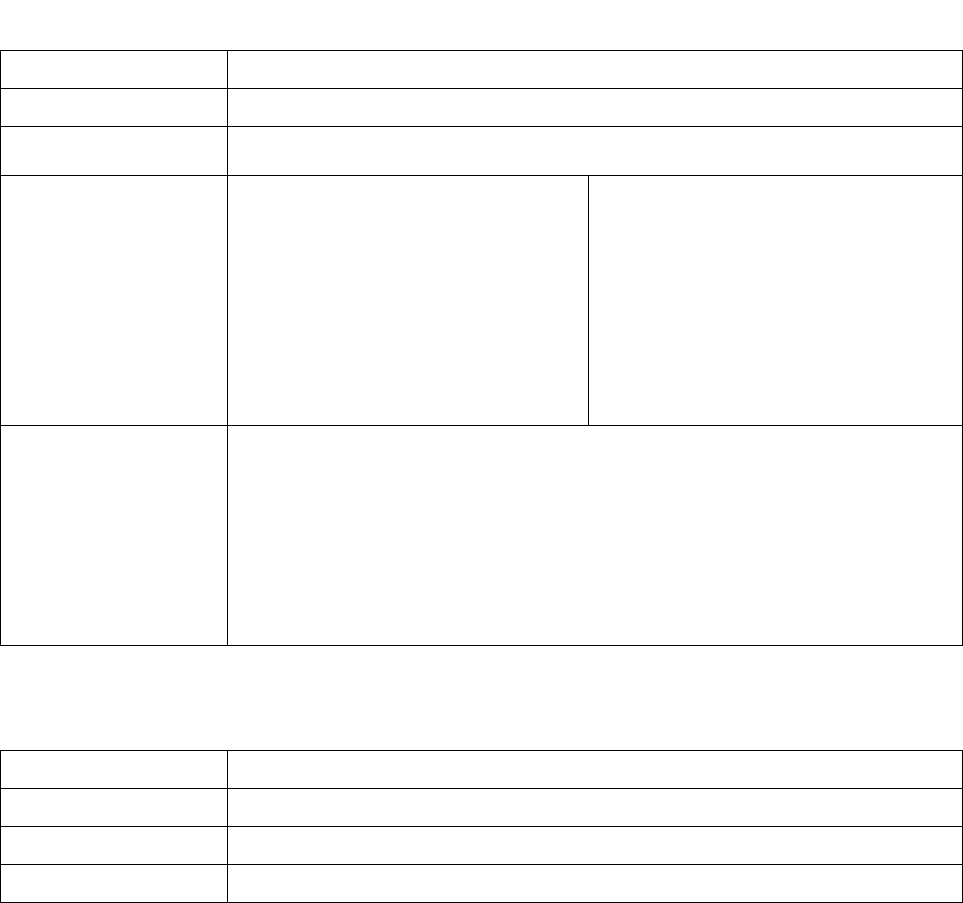
2
Standby time Over 4 days
Operating time 6 hours
Read barcodes per
charge Over 20,000 scans per charge
Decoding depth
& Max. resolution
(1 mil = 0.0254mm)
Long-range series
5 mil: 35-160mm
10 mil: 20-320mm
15 mil: 25-440mm
20 mil: 30-565mm
30 mil: 40-740mm
55 mil: 75-985mm
High-density series
3 mil: 45-90mm
5 mil: 22-130mm
10 mil: 12-225mm
15 mil: 20-305mm
20 mil: 25-395mm
55 mil: 80-730mm
Safety
Laser safety: EN60825-1, class 1
EMC: EN 55022, EN 55024
Electrical safety: EN 60950-1
ESD: ±8KV air discharge, ±4KV direct discharge
Drop resistance: Multiple 1.5m (4.9ft) drops to concrete
Protection class: IP64
Environmental: RoHS compliant
Table 1-2. Technical specifications of BA2118
Radio link 2.4 ~ 2.5GHz (ISM band), Bluetooth V2.0+EDR, class 2
Working range 10 meters (line of sight)
Dimensions Length × Width × Depth: 7.6 × 2.2 × 0.8 cm
Weight 12g
Notes:
1- BA2118 is a Bluetooth USB adapter made by the manufacturer, which supports reliable wireless data
transmission.
2- BA2118 is an optional accessory.
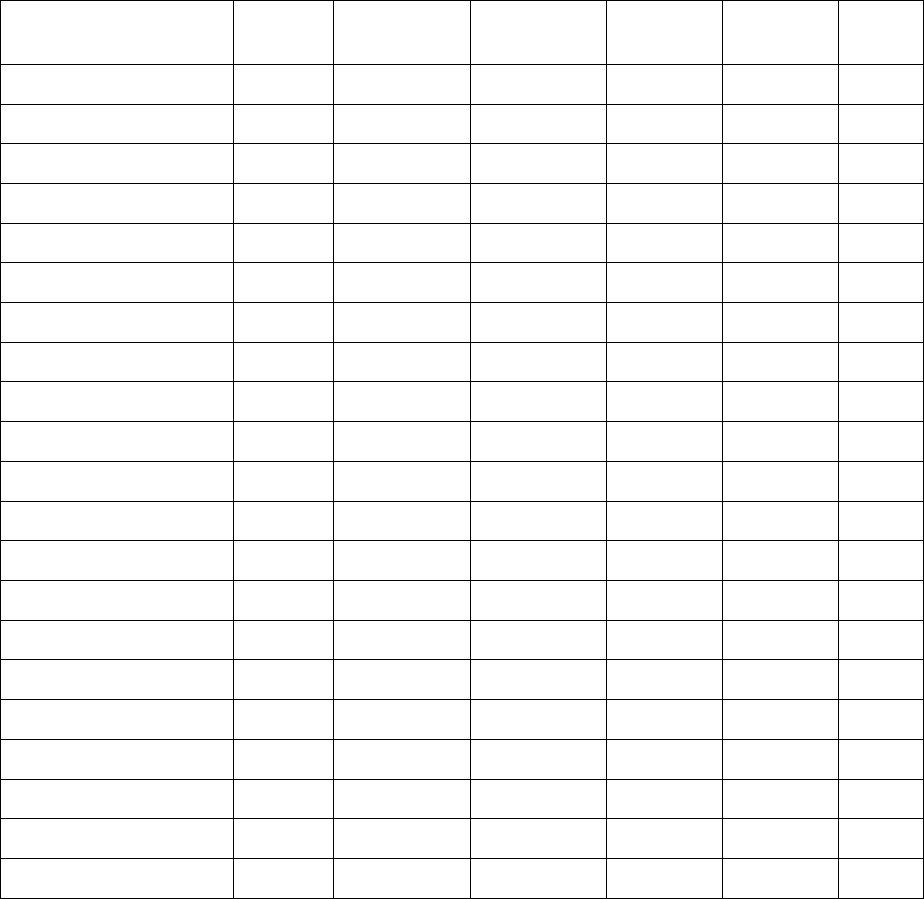
3
1-2 Default settings for each barcode
Table 1-3. Default settings
Code type Read
enable
Check digit
verification
Check digit
transmission
Min. code
length
Proprietary
code ID
AIM
code ID
UPC-A √ √ √ (12)2 A ]Em
UPC-E √ √ √ (8)2 D ]Em
EAN-13 √ √ √ (13)2 A ]Em
EAN-8 √ √ √ (8)2 C ]Em
ISBN/ISSN1 √ √ √ (13)2 A ]Em
Code 39 √ - - 1 M ]Am
Interleaved 2 of 5 √ - - 6 I ]Im
Industrial 2 of 5 - - - 4 H ]Im
Matrix 2 of 5 √ - - 6 X ]Im
Codabar √ - - 4 N ]Fm
Code 128 √ √ - 1 K ]Cm
Code 93 √ √ - 1 L ]Gm
Code 11 - √ - 4 V -
MSI/Plessey - - - 4 O ]Mm
UK/Plessey √ √ - 1 U ]Mm
UCC/EAN 128 √ √ - 1 K ]Cm
China Post √ - - (11)2 T ]Im
GS1 DataBar √ - - (16)2 R ]em
GS1 DataBar Truncated3√ - - (16)2 R ]em
GS1 DataBar Limited √ - - (16)2 R ]em
GS1 DataBar Expanded √ - - 1 R ]em
Note: 1The settings for ISBN/ISSN and EAN-13 must be the same.
2 Fixed-length barcodes.
3The settings for GS1 DataBar Truncated and GS1 DataBar must be the same.
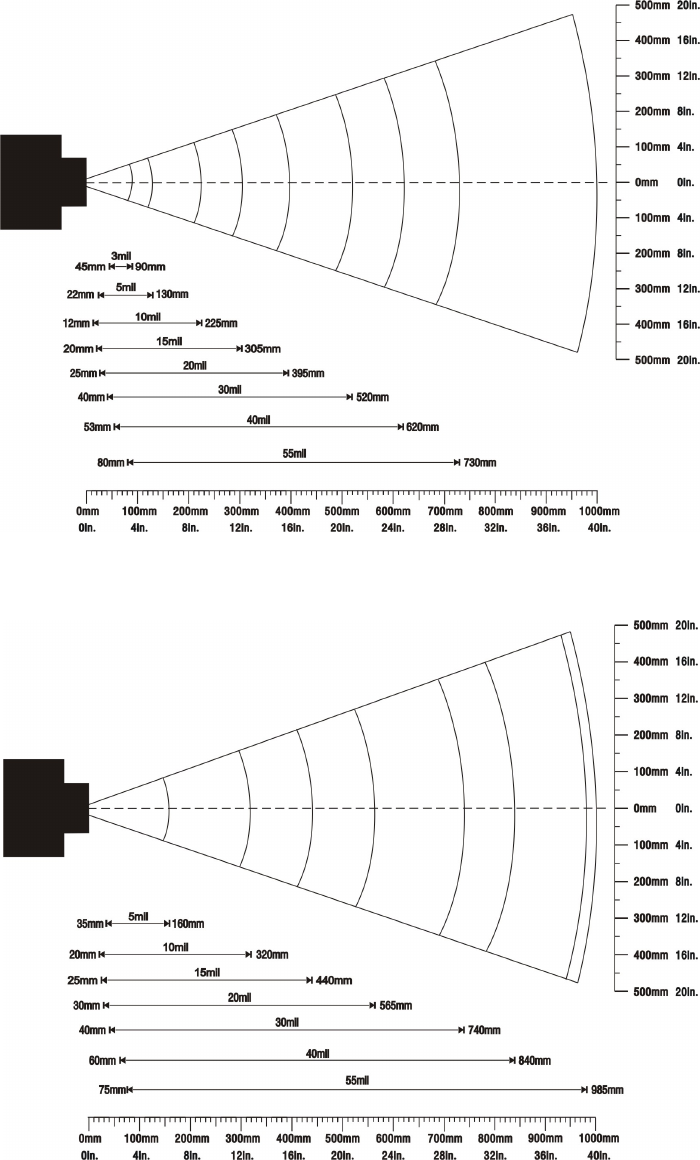
4
1-3 Decode zone
Figure 1-1. Decode zone of high-density series
Figure 1-2. Decode zone of long-range series
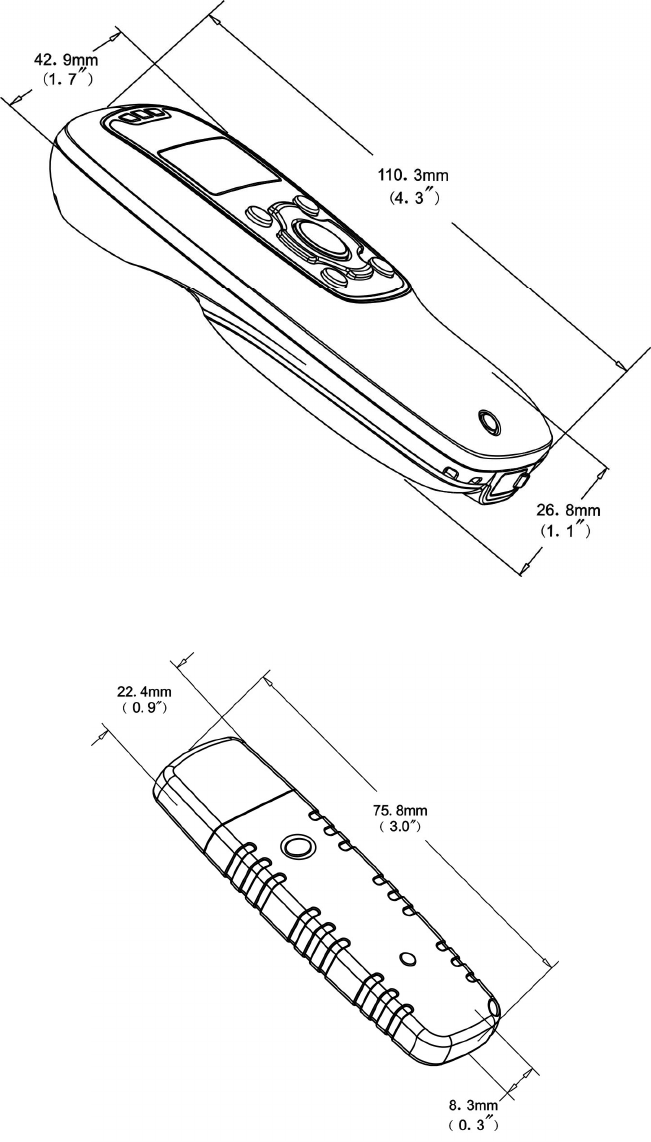
5
1-4 Dimensions
Figure 1-3. Dimensions of the scanner
Figure 1-4. Dimensions of the Bluetooth USB adapter
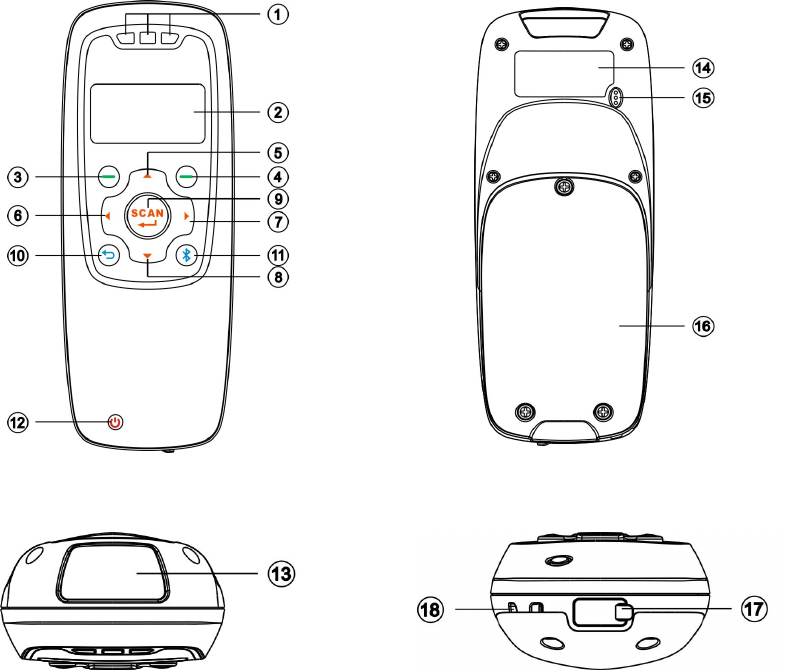
6
1-5 Parts of the scanner
Front view
Back view
Top view
Bottom view
Figure 1-5. Parts of the scanner
○
1 Blue LED (Bluetooth power); Green LED (Decode success); Red LED (Charging indicator)
○
2 LCD
○
3 Left soft key
○
4 Right soft key
○
5 Up navigation key
○
6 Left navigation key
○
7 Right navigation key
○
8 Down navigation key
○
9 Scan/Select key
○
10 Return key
○
11 Bluetooth on/off key
○
12 Power/Sleep key
○
13 Scan window
○
14 Label
○
15 Beeper
○
16 Battery cover
○
17 Mini USB port / Battery charging port (Lift cover)
○
18 Hook for neck/wrist strap
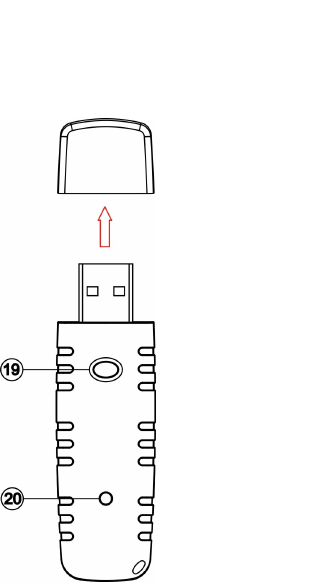
7
1-6 Parts of the Bluetooth USB adapter BA2118
Figure 1-6. Parts of the Bluetooth USB adapter BA2118
○
19 Reset/Firmware upgrade key
○
20 Green LED (Power/Data transmission)
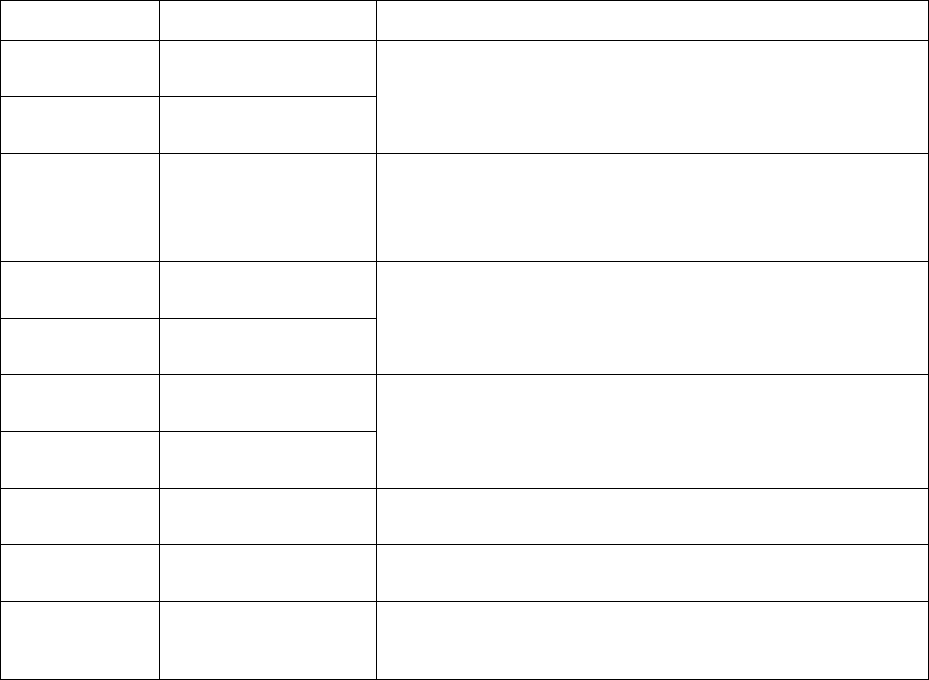
8
1-7 Keys, actions and features
Operations, such as scrolling and selecting menus, moving a cursor, or scanning a barcode, are
controlled by trigger keys and stroke keys.
Table 1-4. Key functions
Part Position1 Key/Action/Feature Description
○
3 Left soft key
○
4 Right soft key
Functionalities are identified by the screen display. In general,
the acknowledge/non-acknowledge of operations are done by
pressing a soft key.
○
9 Scan/Select key
is pressed to scan barcodes when the scanner is not in a menu
status; the select key is pressed to select items when a menu is
activated.
○
5 Up navigation key
○
8 Down navigation key
is pressed to move cursor upward/downward.
○
6 Left navigation key
○
7 Right navigation key
is pressed to move cursor leftward/rightward.
○
10 Return key is pressed to return to previous menu by one step.
○
11 Bluetooth on/off key is pressed to turn on/off the Bluetooth power.
○
12 Power/Sleep key is pressed long to power on/off a scanner; the key is pressed
short to enter/exit sleep mode.
Note: 1See Parts of the scanner for the information about position of keys.
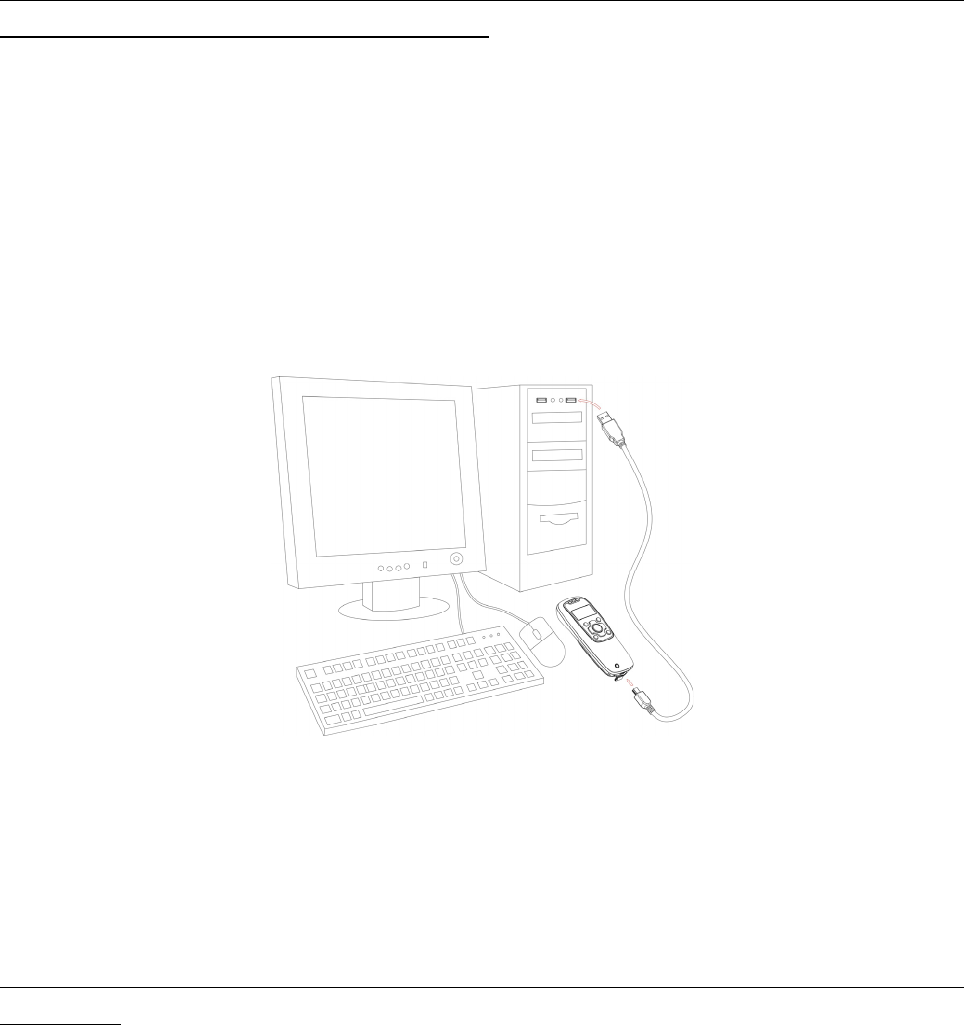
9
2 Introduction to installation
2-1 Installing a USB HID keyboard wired scanner
Note: The default interface of the scanner is BT HID Keyboard. Please change the interface to USB HID
Keyboard (See Data TransferÆUSB HID Keyboard).
1. Refer to Figure 2-1, plug one end of the USB cable to the scanner. Plug the other end into the
USB port of the computer.
2. For example: Using Microsoft Windows operation system, the system gives message on “new
hardware found – USB HID input device found”, then driver will be installed on request.
3. After successfully installing the new hardware, message will be given: “hardware installed
successfully and ready to use”.
4. If any problem is encountered during the installation process, unplug the USB cable from the
computer and repeat step 1-2.
Figure 2-1. Diagram of connecting the scanner to PC
2-2 Installing a USB virtual COM wired scanner
Note: The default interface of the scanner is BT HID Keyboard. Please change the interface to USB
Virtual COM.
1. Refer to Figure 2-1, plug one end of the USB cable to the scanner. Plug the other end into the
USB port of the computer.
2. For example: Using Microsoft Windows operation system, the system gives message on “new
hardware found – USB Virtual COM found” for USB virtual COM, then driver will be installed on
request.
3. After successfully installing the new hardware, message will be given: “hardware installed
successfully and ready to use”.
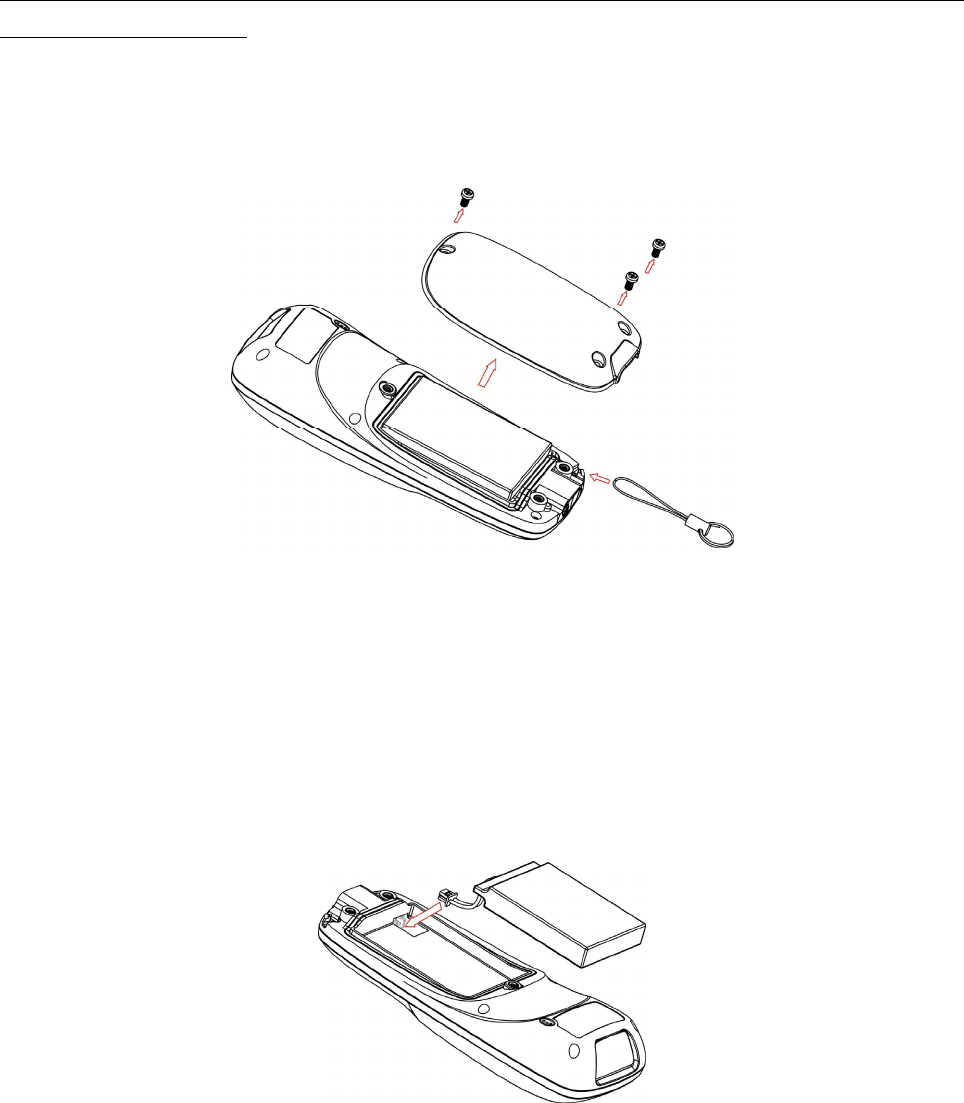
10
4. If any problem is encountered during the installation process, unplug the USB cable from the
computer and repeat step 1 to step 2.
2-3 Attaching the neck/wrist strap
Note: The neck/wrist strap protects the scanner from being damaged as a result of it being dropped by
mistake during movement.
1. Refer to Figure 2-2, remove the 3 screws from the battery cover (one at a time).
2. Attach the neck/wrist strap by hanging the strap ring around the raised part at the corner.
3. Screw in the 3 screws to tighten the scanner and the battery cover.
Figure 2-2. Diagram of attaching the neck/wrist strap
2-4 Replacing the Lithium-ion battery
1. Refer to Figure 2-2, remove the 3 screws from the battery cover (one at a time).
2. Refer to Figure 2-3, load the battery while sliding it with the connection on the battery pack on the
scanner body.
3. Re-place the battery cover, screw in the 3 screws to tighten the scanner and the battery cover.
Figure 2-3. Diagram of replacing the Lithium-ion battery
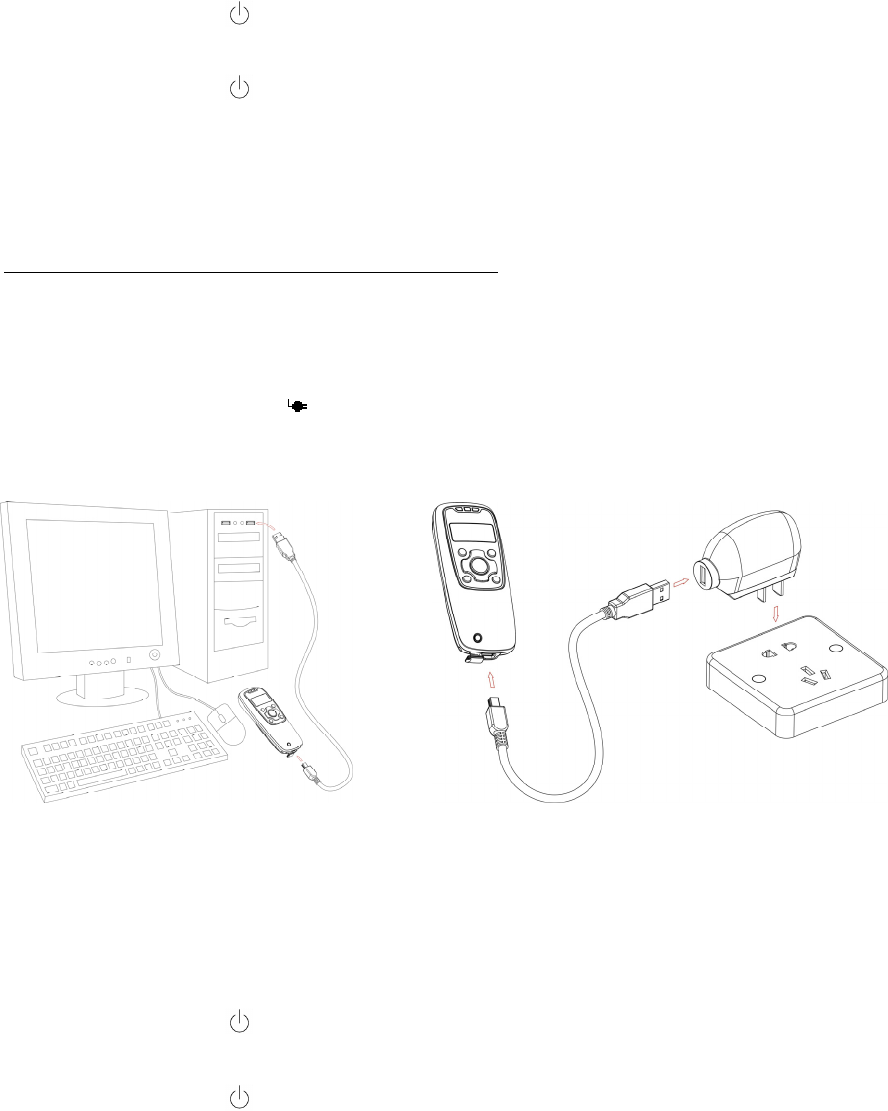
11
3 Getting started
3-1 Power on/off scanner
Power on scanner:
Press the Power/Sleep key (see Parts of the scanner) for two seconds.
Power off scanner:
Press the Power/Sleep key (see Parts of the scanner) for two seconds.
3-2 Charge battery
1. Please charge the battery before the first time of use. There are two methods of charging battery as
demonstrated in Figure 3-1. The charging indicator (red LED) on the scanner is turned on when
the charging is in process. When the charging process completes, the red LED is turned off.
2. Charging time: 3.5 hours for fully charged.
3. In scanning status, the icon is seen at the top of the screen display when the scanner is
connected to a PC with the USB cable.
Method I
Method II
Figure 3-1. Diagram of charging battery
3-3 Enter/Exit sleep mode
Enter sleep mode:
Press the Power/Sleep key (see Parts of the scanner ○
12 ) for 0.5 seconds.
Exit sleep mode:
Press the Power/Sleep key for 0.5 seconds.
3-4 Power on/off Bluetooth
Bluetooth indicator:
In scanning status, the status of the Bluetooth is shown by icons.
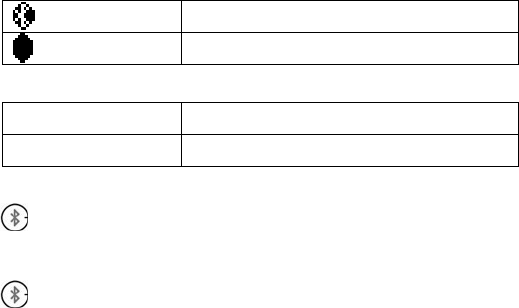
12
Bluetooth is on.
Bluetooth is off.
The status of the Bluetooth is also indicated by the blue LED.
on Bluetooth is on.
off Bluetooth is off.
Power off Bluetooth:
Press the Bluetooth key (see Parts of the scanner○
11 ).
Power on Bluetooth:
Press the Bluetooth key .
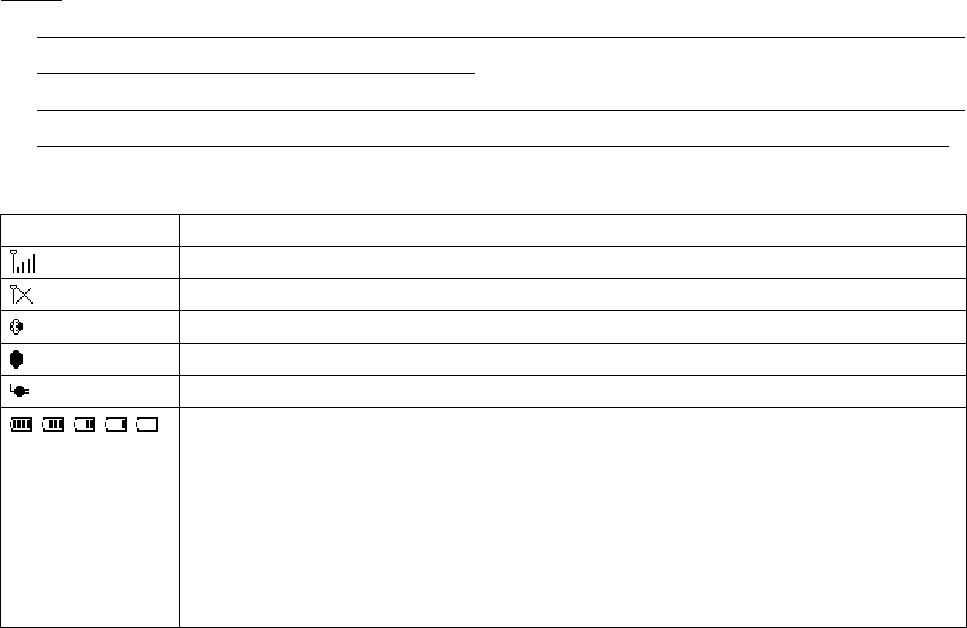
13
4 Introduction to LCD display
4-1 LCD display icons
Notes:
1- The LCD screen is designed to display barcode scanning, Bluetooth network establishing, data
transfer, system setting and other information.
2- The display area is 64 dots (V) by 128 dots (H). The backlight will be switched off automatically if
time of no operation exceeds a programmable duration (see System SettingÆBackLight Timeout).
Table 4-1. LCD display icons
Icon Description
Bluetooth network is working.
Bluetooth network is disconnected.
Bluetooth module is on.
Bluetooth module is off.
Scanner is connected to a PC (or other instrument) with USB cable.
Battery capacity (from the left):
• Battery is fully charged (100% - 75% charge remains).
• 75% - 50% charge remains.
• 50% - 25% charge remains.
• 25% - 10% charge remains.
• 10% - no charge remains. When the battery capacity is lower than 10%, the battery
icon blinks and an error tone sounds once every minute.
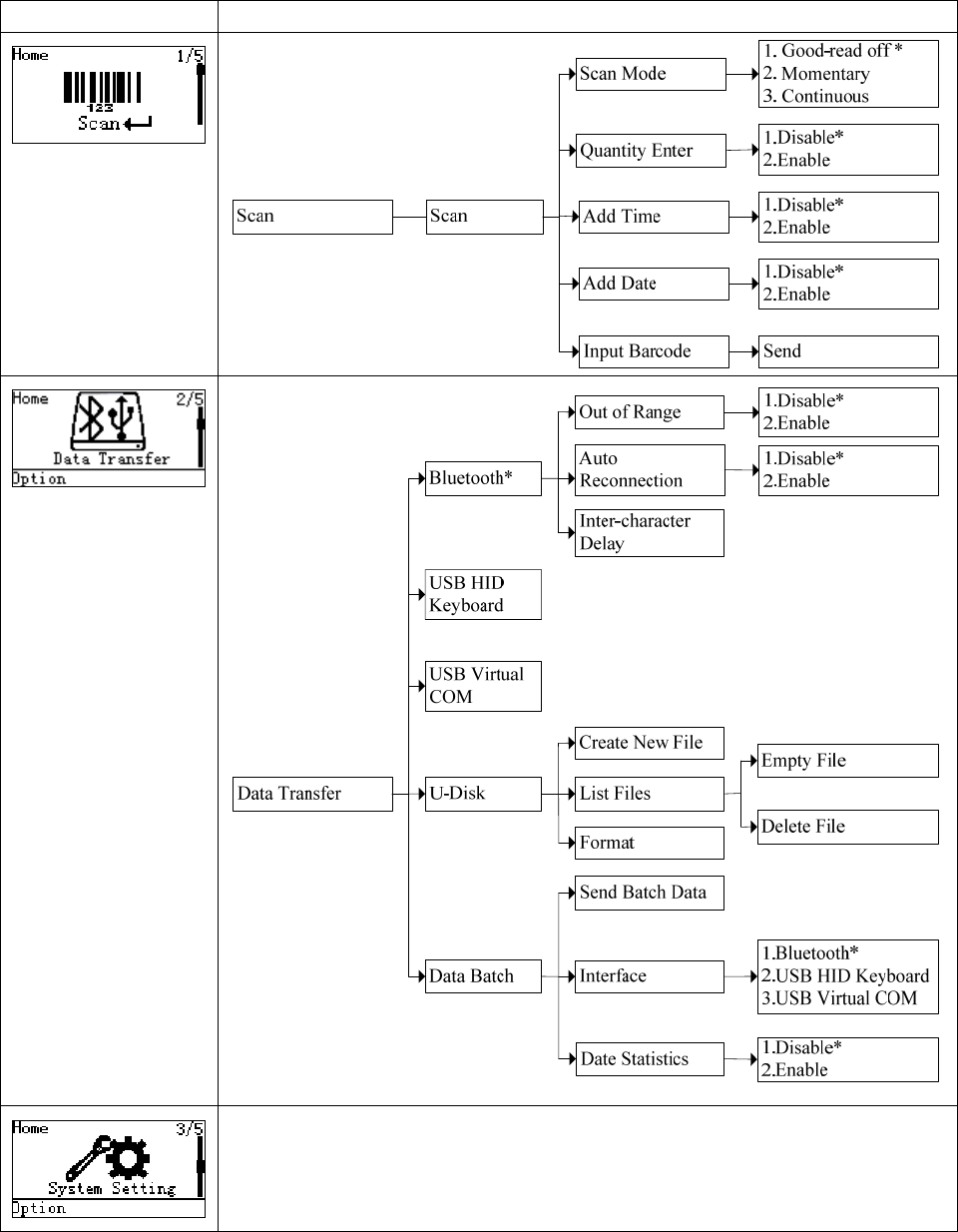
14
4-2 LCD display menu
The Home menu consists of five items, which are described in details in the following chapters. Table
4-2 depicts the hierarchy chart of the LCD display menu.
Table 4-2. LCD display menu
Menu Hierarchy chart
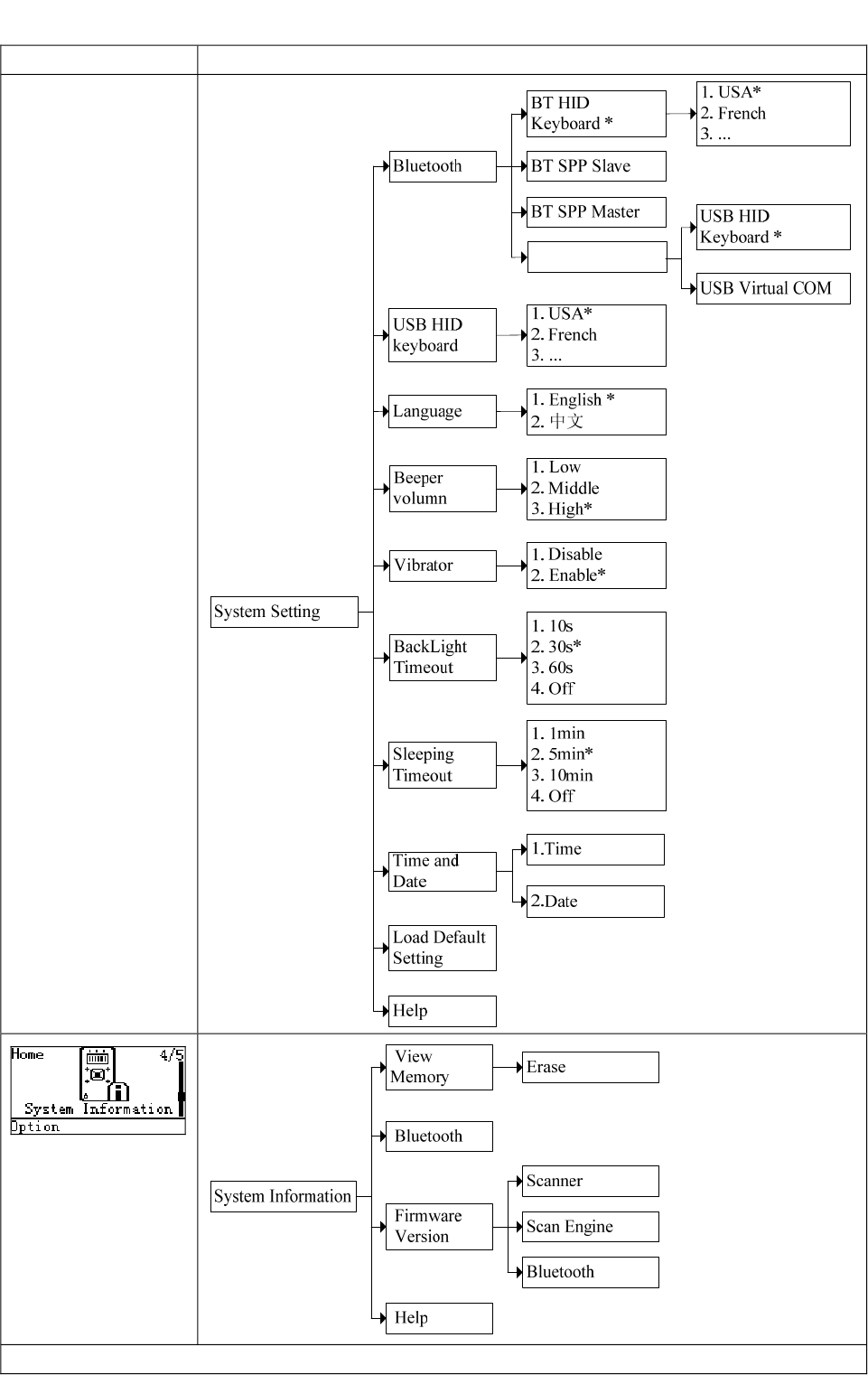
15
Menu Hierarchy chart
Note: Items that are labeled ‘*’ are default selections.
BA2118
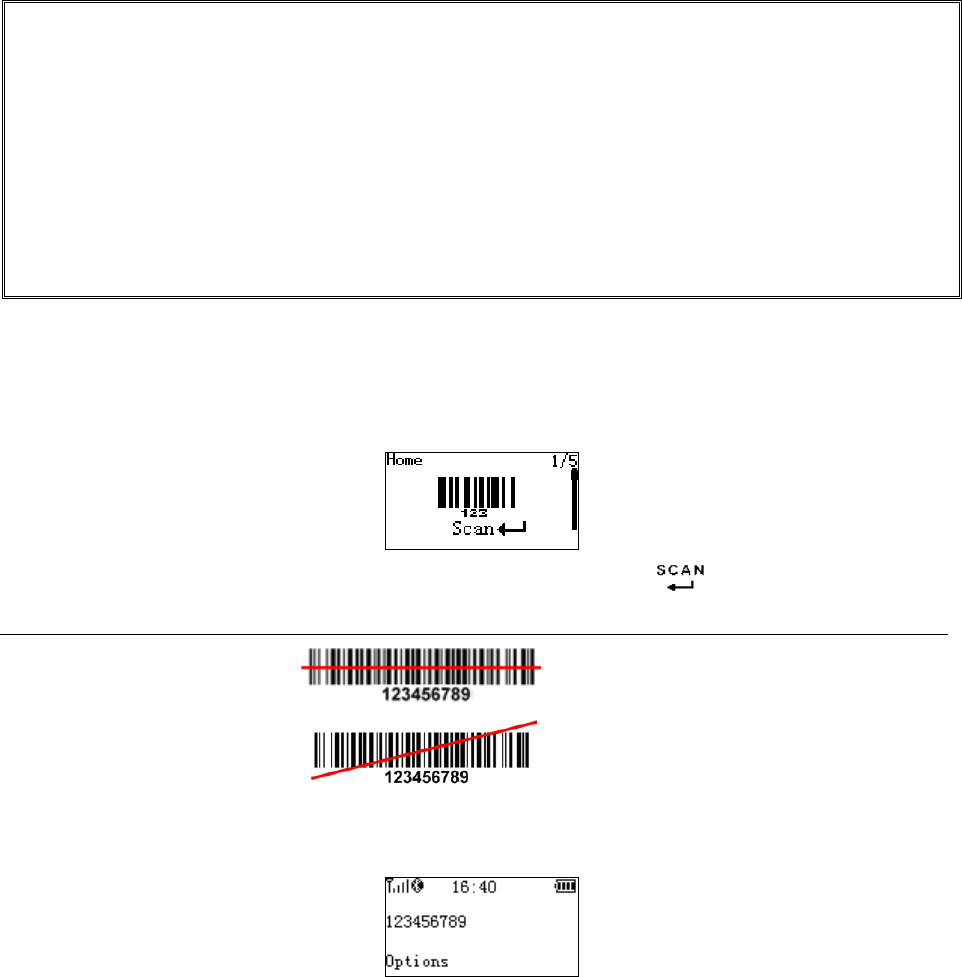
16
5 Operations of the scanner
Note:
1. Please establish a Bluetooth network and hold the scanner in the range of the network before the
first time of scanning barcodes (See chapters of Configure Bluetooth HID keyboard profile
communication, Configure Bluetooth SPP slave profile communication, and Configure Bluetooth SPP
master profile communication).
2. The scanner can perform a barcode scan operation even though no Bluetooth network is available.
However, the scanner may react in a way that differs from what is described here if no Bluetooth
network is working.
5-1 Scan
Steps:
Step 1: When the scanner is powered on, the LCD screen is displayed as below.
Step 2: Hold the scanner close to the barcode and press the Scan Key .
Note: When the scanner is scanning, ensure the scan line crosses every bar and space of the symbol.
RIGHT
WRONG
Step 3: The scanner port emits a laser to scan the barcode. The decode success indicator lights green
when the scan is successful. The window will show as below.
----------------------------------------------------------------------------------------------------------------------
Scan mode
Good-read off - The Scan key must be pressed once to activate scanning. The light source of scanner
stops scanning when there is a successful reading or no code is decoded after the Stand-by duration
elapsed.
Momentary - The Scan key acts as a switch. Press the key to activate scanning and release the key to
stop scanning. The light source of scanner stops scanning when there is a successful reading or no
code is decoded after the Stand-by duration elapsed.
Continuous - The scanner always keeps scanning, and it does not matter when the Scan key is released
or duration is elapsed.

17
----------------------------------------------------------------------------------------------------------------------
Quantity enter
User can select to enable/disable the Quantity Enter. When Quantity Enter is enabled, user can set the
number (0 to 9999) of barcode transmissions. For example, a barcode “123456789” is read. Five
“123456789” will be received by the host, given that the quantity is 5. The quantity decides how many
identify barcodes a host receives upon a single successful read.
The following steps demonstrate the procedure to set a quantity.
Step 1: Enable Quantity Enter, press the Scan Key to read a barcode.
Example display:
Step 2: Press Right Soft Key to the window below.
Step 3: Use Navigation Keys to move the cursor, Scan/Select Key to select number(s), Right Soft Key to
delete selected number(s). And then press Left Soft Key to continue.
Step 4: Finally press Left Soft Key to complete.
----------------------------------------------------------------------------------------------------------------------
Add Time/Date
The time/data information can be added as an appendix to a barcode by enabling the Add Time/Date.
Example display when Add Time is enabled:
Example display when both Add Time and Add Date are enabled:
----------------------------------------------------------------------------------------------------------------------
Input barcode
18
Using the virtual keypad, user can input a barcode manually, and then send the barcode to the host.
Make sure a communication link (Bluetooth network or USB cable) is working.
5-2 Data Transfer
----------------------------------------------------------------------------------------------------------------------
Bluetooth
See System Setting - Bluetooth for instructions to establish a Bluetooth network. Three options are
listed below.
Out of range batch- The scanner starts storing barcode data when it loses its connection to a remote
host (for example, when a user holding the scanner walks out of range). Data transmission is triggered
by reestablishing the connection with the host (for example, when a user holding the scanner walks
back into range).
Auto reconnection- When scanner’s Bluetooth is power on, it will try to establish the wireless
connection with the host which it last connected, if Auto Reconnection is enabled.
Inter-character delay- This delay is inserted after each data character transmitted. Some Bluetooth
communication needs large delay to avoid data missing.
----------------------------------------------------------------------------------------------------------------------
USB HID keyboard
When the scanner is USB connected to a PC, it will be identified as a USB HID keyboard and behaves
as a USB wired scanner.
----------------------------------------------------------------------------------------------------------------------
USB Virtual COM
When the scanner is USB connected to a PC, it will be identified as a USB Virtual COM and acts as a
RS-232 wired scanner.
----------------------------------------------------------------------------------------------------------------------
U Disk
Barcode data is always stored in a text file (TXT file), that is, the scanner functions as a barcode data
collector. The scanner will be identified as a USB removable driver when it is USB connected to a PC.
The scanner decides target file to store barcodes according to following rules:
9 If a file is selected by the user, the selected file will be the target file.
9 If there is no file in the U-Disk, a file will be created and named “TARGET.txt” by the scanner when it
is powered on or restart. In this case, TARGET.txt will be the target file.
9 The file selected to be the target file is labeled √.
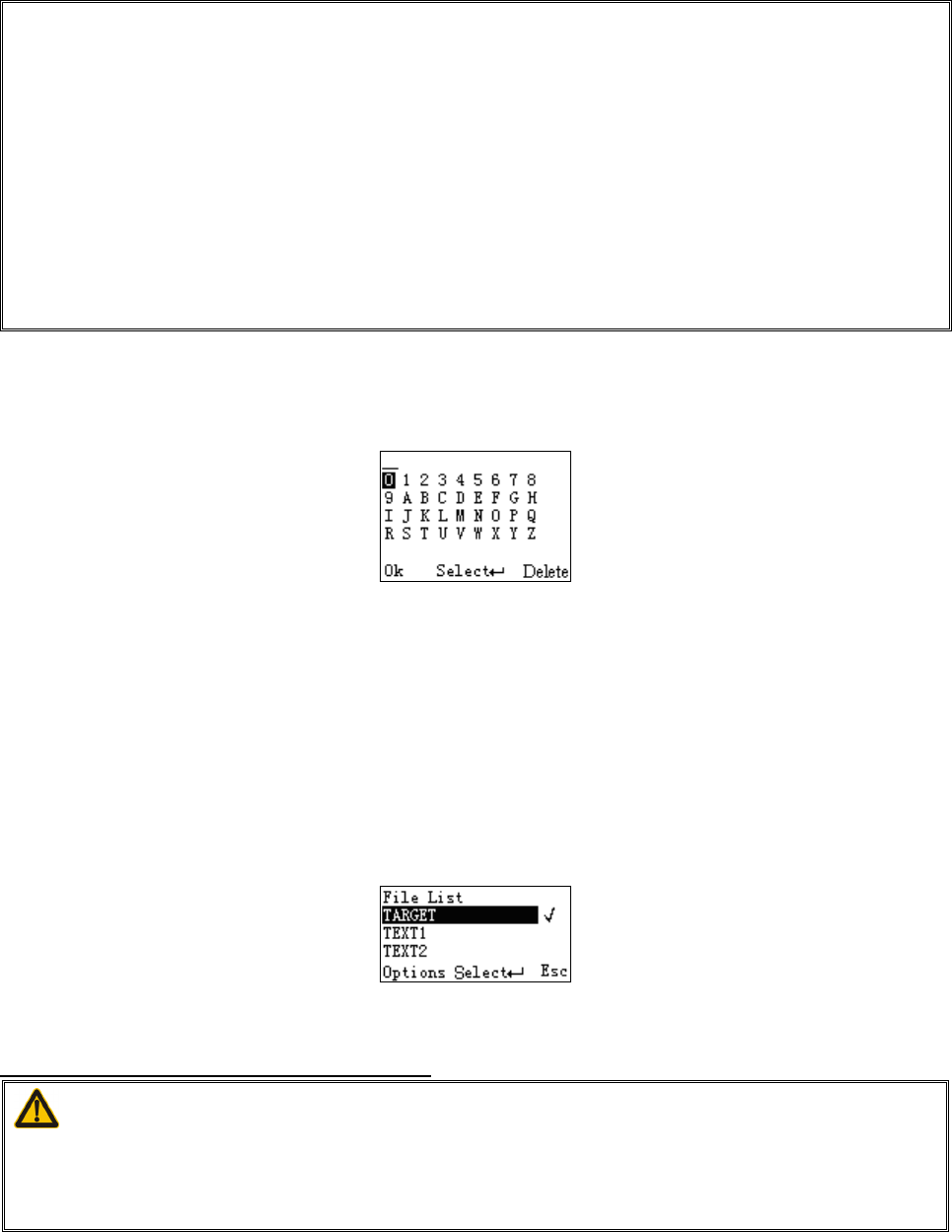
19
----------------------------------------------------------------------------------------------------------------------
Create New Files
Note:
1. Files can be opened/edited/saved/renamed/deleted by the user of a PC and
created/emptied/deleted by the user of a mobile scanner.
2. A valid filename, not including the suffix, is composed of up to 8 characters from three groups:
Upper case letters “A”–“Z”, Numbers 0–9 and special sign ! # $ % & ' ( ) - @ ^ _ ` { } ~ .
3. Only part of the filename will be displayed if there are more than 8 characters in a filename. e.g.
"TextFile1Mine.txt" will be shown as "TEXTFI~1.TXT"
4. Lower case is not supported and “a”-“z” will be displayed as “A”-“Z” respectively for a filename.
e.g. “ABCabc.txt" will be shown as "ABCABC.TXT".
When a file is created, the filename can be input by using the virtual keyboard. Use Navigation Keys to
move the cursor, Scan/Select Key to select number(s), Right Soft Key to delete selected number(s). And
then press Left Soft Key to complete.
----------------------------------------------------------------------------------------------------------------------
List Files
This menu can be selected to list all files in the root directory. The file selected to be the target file is
labeled √. The operations described below are imposed to the cursor-on file, which is not necessary to
be the target file.
Example:
Options Menu
Note: Press Left Soft Key to popup this menu.
Caution:
Empty and Delete operations are not undoable. It is strongly recommended to back up
the data before empty or delete operation.
----------------------------------------------------------------------------------------------------------------------
Empty/Delete Files
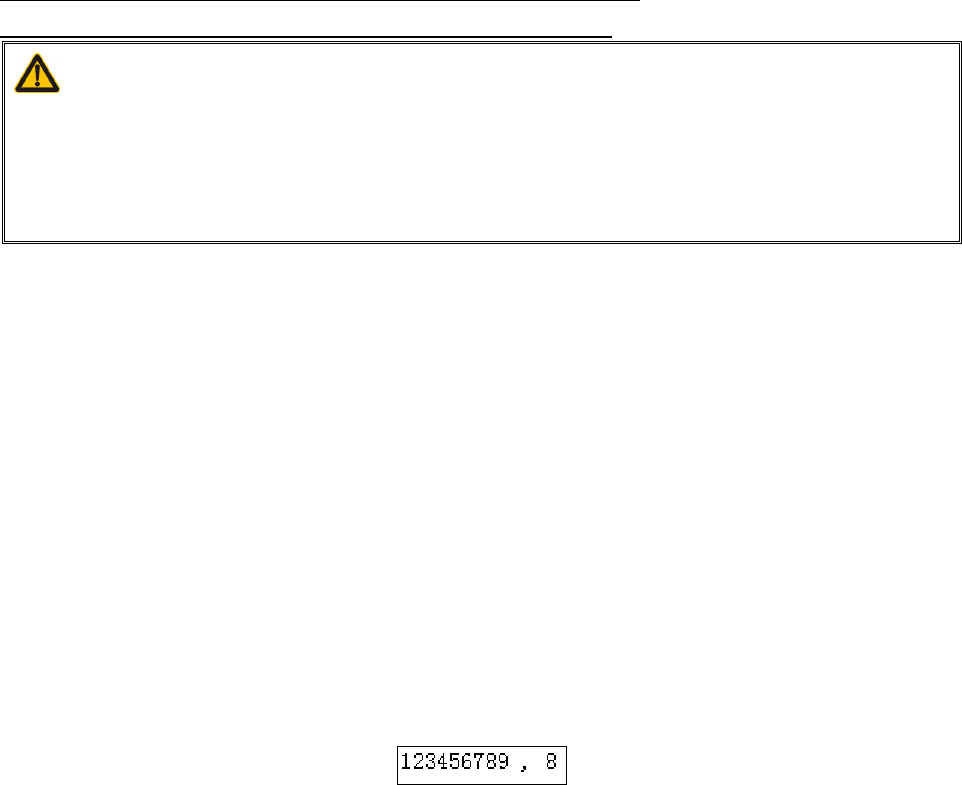
20
If the U-disk is almost full, occupied room can be released by emptying/deleting some files.
A target file is protected by system and prevented from being deleting. In this case, the file that is wanted
to be deleted should be deselected and then deleted.
----------------------------------------------------------------------------------------------------------------------
Format a U Disk
Note 1: The format function is a quick way to empty a whole U Disk.
Note 2: Please format the U Disk once before the first time of use.
Caution:
1. Format operation will erase all data on the disk.
2. Format operation is not undoable. It is strongly recommended to back up the data
before format operation.
----------------------------------------------------------------------------------------------------------------------
Data batch
The scanner starts storing barcode data in Date Batch mode. The collected barcode data can then be
sent to a host via Bluetooth/USB. Three options are listed below.
Send batch data- Data transmission is triggered by this menu command. Before undertaking this
operation, make sure a communication link (Bluetooth network or USB cable) is working.
Interfaces- There are three communication interfaces: Bluetooth, USB HID keyboard, USB virtual
COM. A Bluetooth link is needed in the first case (See System SettingÆBluetooth).
Data statistics- User can select to enable/disable the Data Statistics. When it is enabled, the number
of a barcode would be added to the end of the barcode. The eighth barcode is “123456789” in the
example below.
Example:
5-3 System Setting - Bluetooth
5-3-1 Bluetooth functionalities
The scanner can be configured to send data to a PC/Notebook/PDA/other instrument which has an
integrated Bluetooth module or is connected with an external Bluetooth USB adapter. A diagram of
Bluetooth functionalities and a table of various Bluetooth profiles are shown below, respectively:
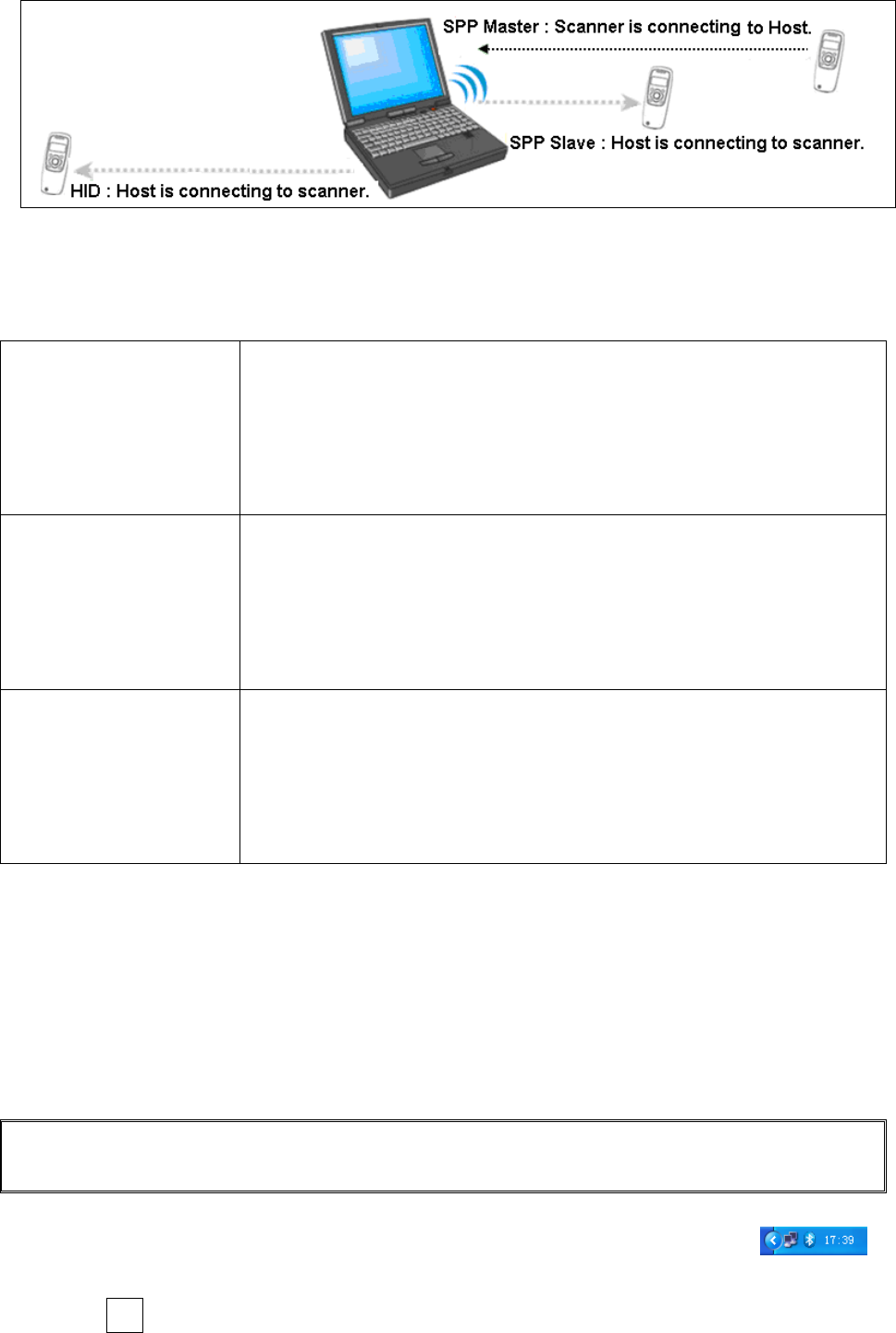
21
Figure 5-1. Diagram of Bluetooth functionalities
Table 5-1. Various Bluetooth profiles
HID Keyboard The scanner connects to the PC/host via Bluetooth and behaves like a
keyboard. The scanner accepts incoming connection requested from a
remote device and is the slave.
SPP slave The scanner connects to the PC/host via Bluetooth and behaves like
there is a serial connection. The scanner accepts incoming connection
requested from a remote device and is the Slave.
SPP master The scanner connects to the PC/host via Bluetooth and behaves like
there is a serial connection. The scanner initiates the connection to the
remote device and is the Master.
A master SPP mainly differs from a slave one in the process of connection and they are identical in the
process of use in terms of function.
Bluetooth-enabled smart phones and PDAs can host the scanner in general. However, ordinary mobile
phones with Bluetooth function can not be a host of the scanner because in most cases neither HID nor
SPP profile is supported by them.
5-3-2 Configure Bluetooth HID keyboard profile communication
Note: Make sure the Bluetooth module of the scanner is powered on (blue LED is on) and the
selected profile is System SettingÆBluetoothÆBT HID Keyboard.
Step1. Plug a Bluetooth USB adapter into the USB port of the computer.
Step2. Double-click the Bluetooth icon at the right bottom corner on Windows OS ( ).
Alternatively, you may go to Control Panel->Bluetooth Device.
Step3. Click Add to search devices nearby.
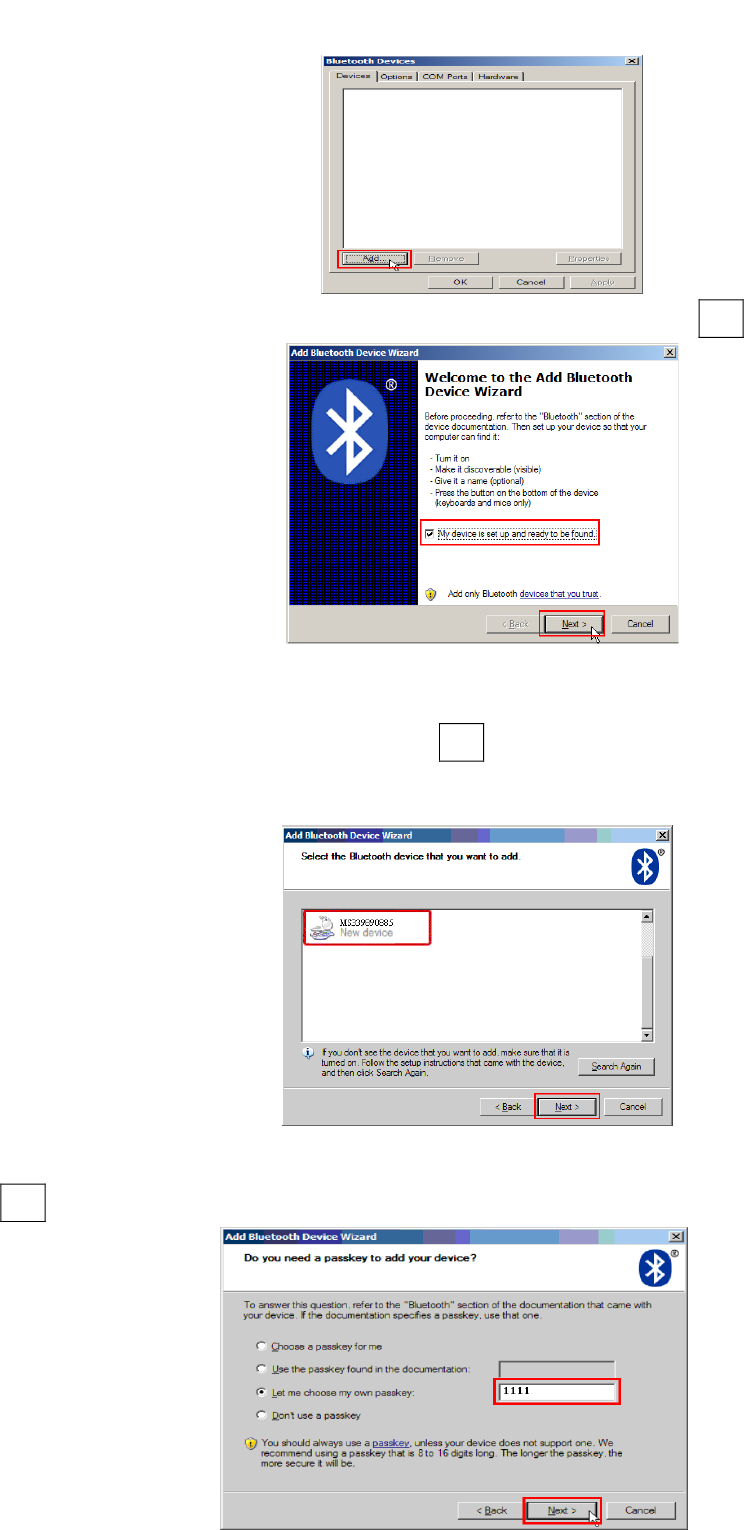
22
Step4. Click to select “My device is set up and ready to be found” and click Next.
Step5. It takes a few seconds for the Wizard to search devices.
The scanner will appear with its serial number as the device name. If the target scanner is seen on the
list, click and select the target scanner. Click Next. If the target scanner does not appear on the list,
click [Search Again] to refresh the list.
Step6. Click and select “Let me choose my own passkey”. Enter a passkey for authentication and click
Next.
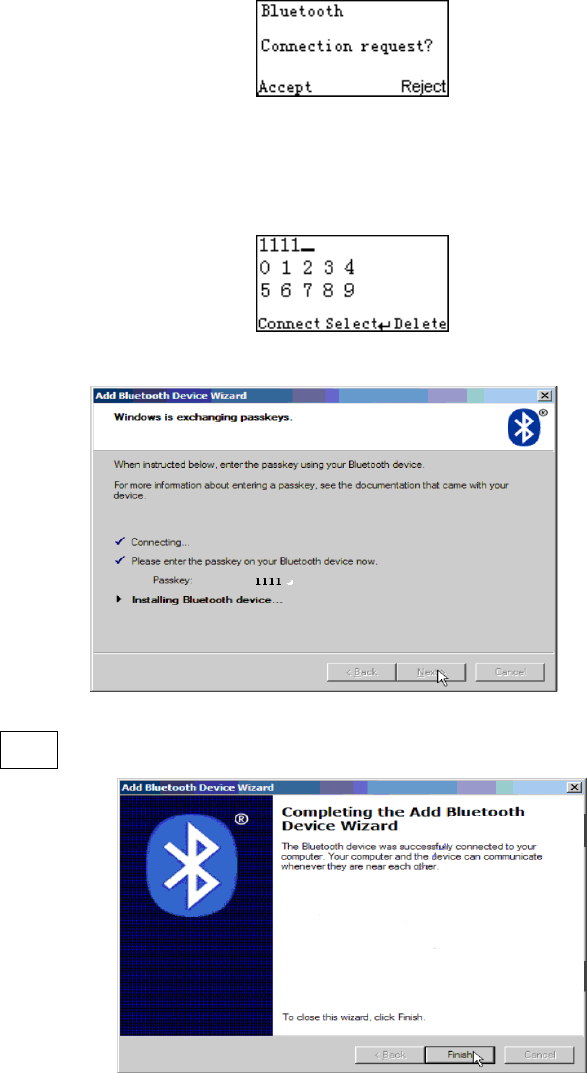
23
Step7. The scanner promotes the user to accept the connection request. Press Left Soft Key to accept.
Step8. Enter a passkey which is exactly the same as that entered from the PC. Use Navigation Key to
move the cursor, Scan/Select Key to select number(s), Right Software Key to delete selected number.
Finally press Left Software Key to continue.
Step9. Wait for a few seconds for Windows to exchange passkeys.
Step10. Click Finish
Step11. Now the target scanner will be listed as shown below.
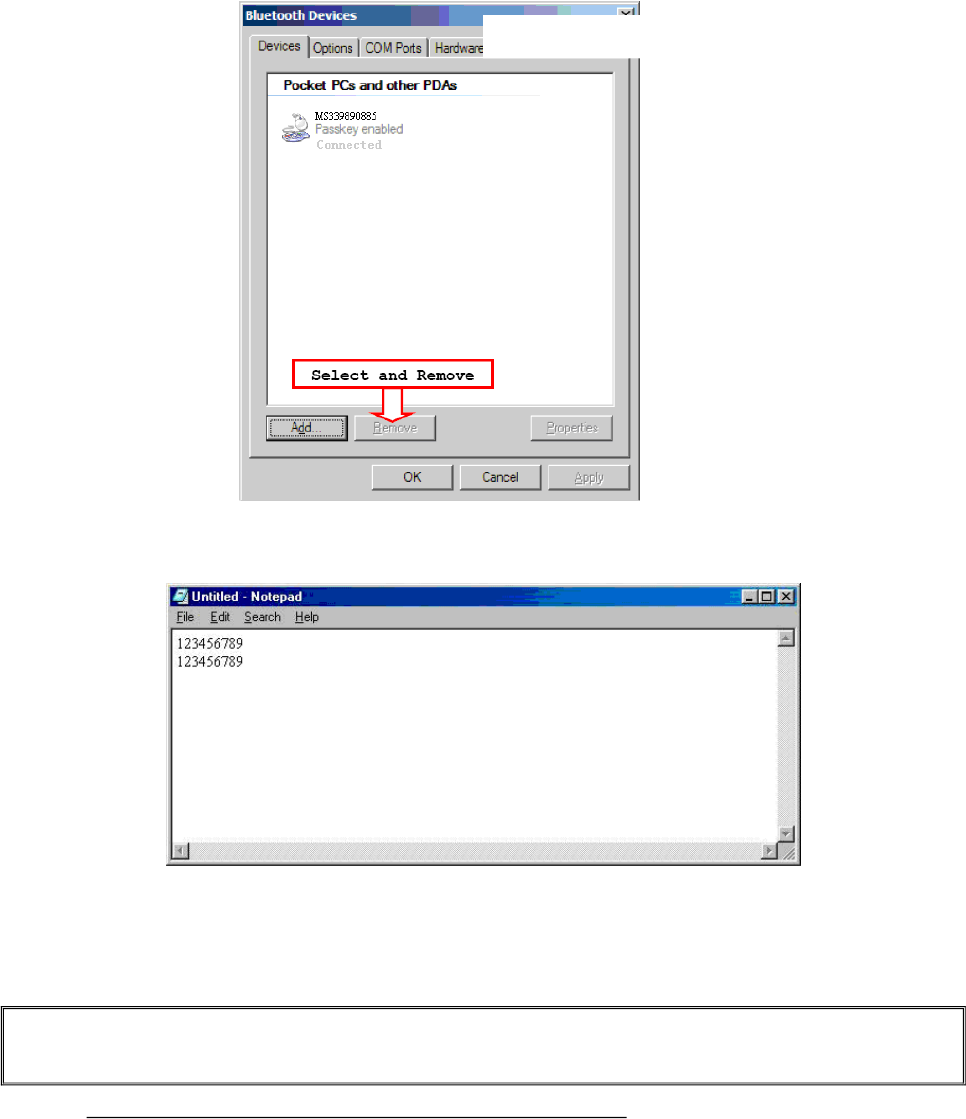
24
Step12. Run the desired application, such as a Notepad and scan barcodes to check data transmission.
5-3-3 Configure Bluetooth SPP slave profile communication
Note: Make sure the Bluetooth module of the scanner is powered on (blue LED is on) and the selected
profile is System SettingÆBluetoothÆBT SPP Slave.
Step1-9: The same as Configure Bluetooth HID keyboard step 1~9.
Step10. Click [Finish]
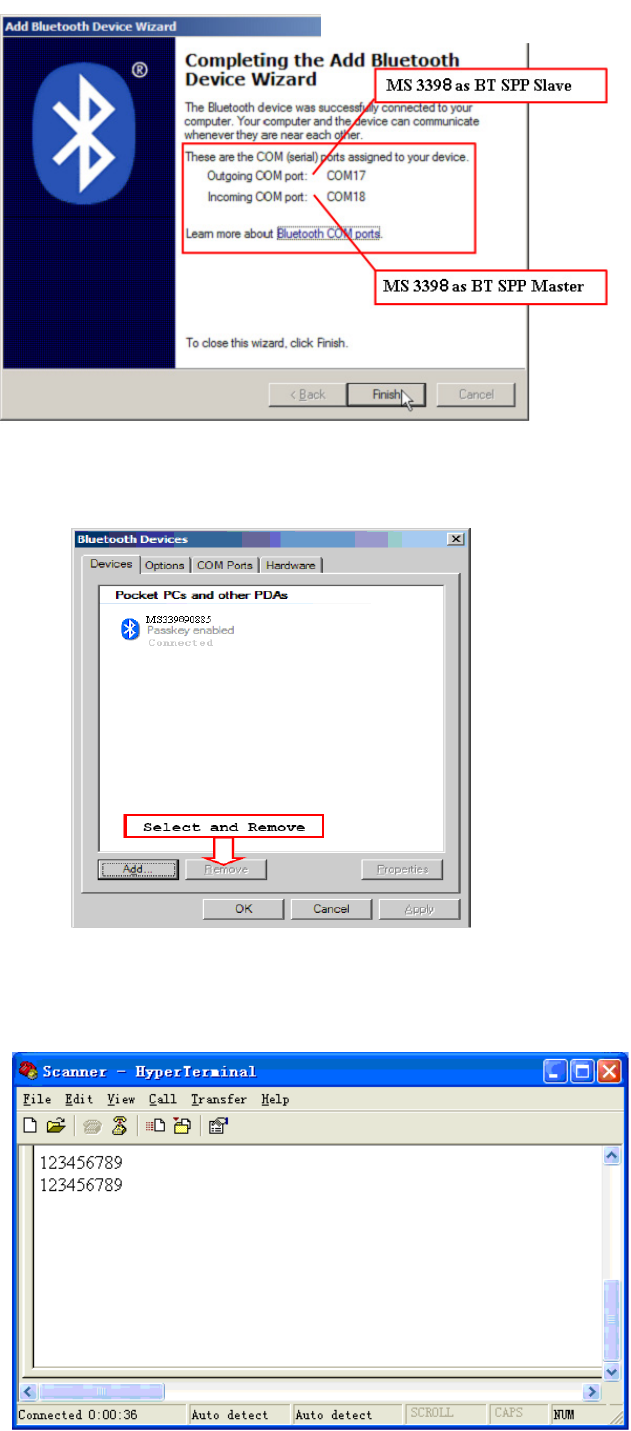
25
Step11. Now the target scanner will be listed as shown below.
Step12. Run a Serial Port Tool, e.g. HyperTerminal on your computer. This step guarantees the
scanner to complete establishing Bluetooth communication. And then scan a barcode to confirm the
success of data transmission.
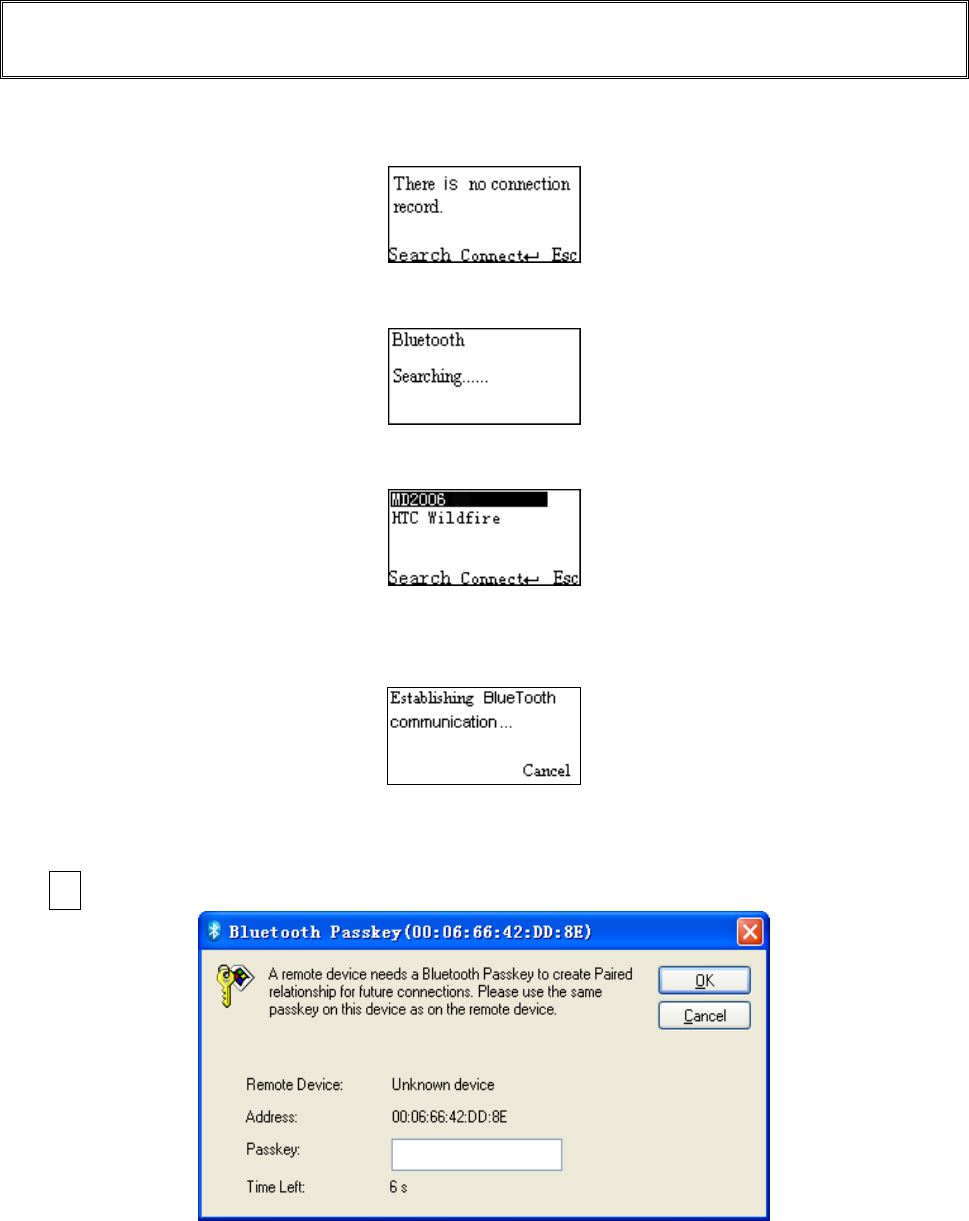
26
5-3-4 Configure Bluetooth SPP master profile communication
Note: Make sure the Bluetooth module of the scanner is powered on (blue LED is on) and the selected
profile is System SettingÆBluetoothÆBT SPP Master.
Step1. Press Left Soft Key to the window below. If the scanner has no connection record, it will show
the indication” There is no connection record.”
Step2. Press Left Soft Key to the window below for searching.
Step3. Wait for about 20 seconds and then the devices list will be shown.
Step4. Use Navigation Key to move the cursor and press Scan/Select Key to connect to the Bluetooth
USB adapter.
Step5. The remote device will promote user to accept the connection request, and then user enters the
passkey. The default passkey of the Bluetooth module of the scanner is “0000”. So enter “0000”, and
click OK.
Step6. The Bluetooth device connected to the scanner is labeled √.
Step7. If you want to disconnect the Bluetooth device connected successfully before, you can press
Scan/Select Key to disconnect it.
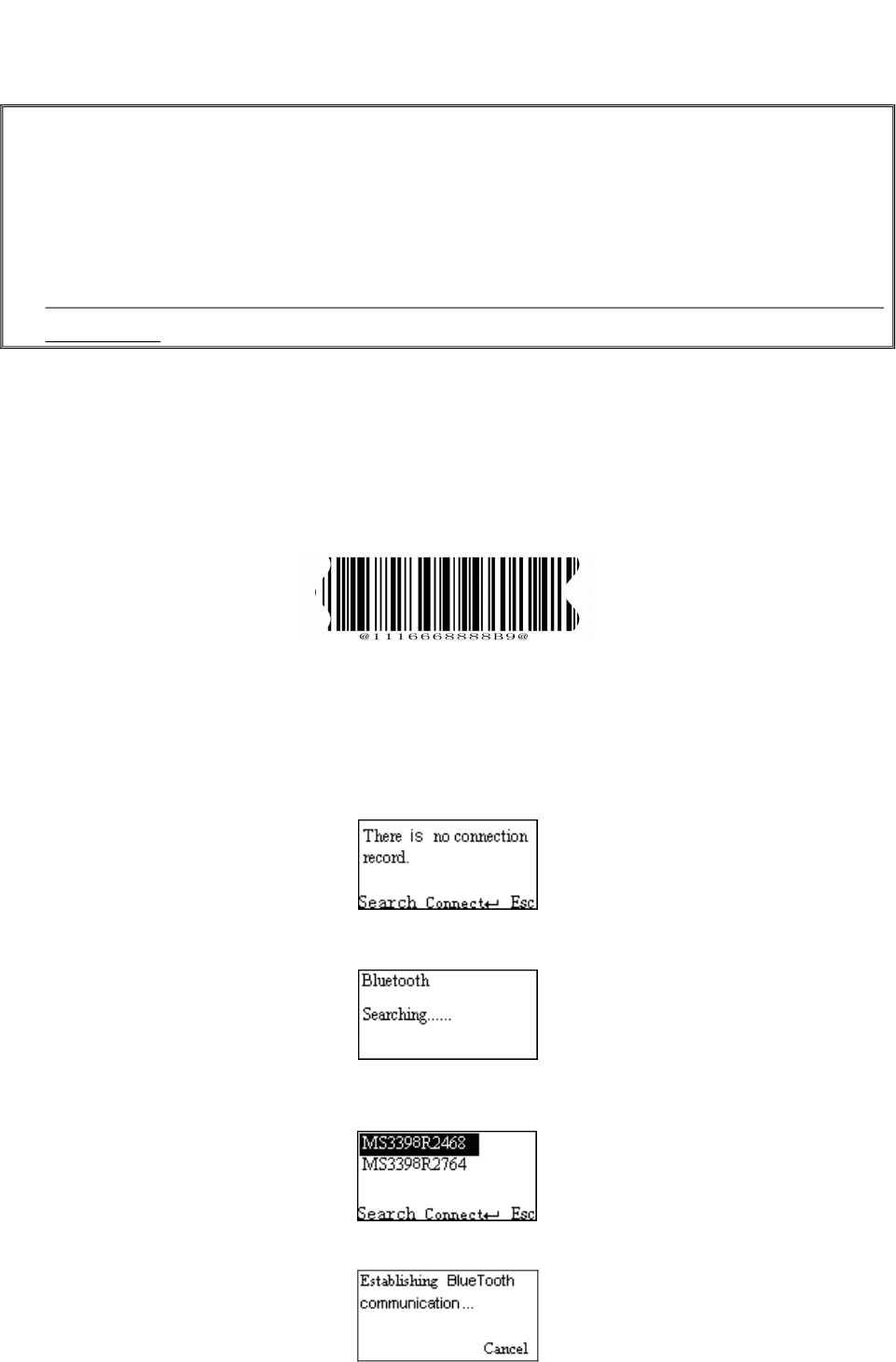
27
5-3-5 Configure Bluetooth USB adapter BA2118
Notes:
1. BA2118 is provided by the manufacturer to support reliable wireless data transmission and is
advised in applications whereas unacknowledged communication is unacceptable.
2. Make sure the Bluetooth module of the scanner is powered on (blue LED is on) and the selected
profile is System SettingÆBluetoothÆBA2118.
3. By default, the profile of the BA2118 is “USB HID keyboard”. An alternative option is “USB
virtual COM”.
There are two methods to setup the Bluetooth communication.
Method I: scanning special barcode.
There is a barcode on the back of BA2118 as shown below. Scan the barcode. The scanner will beep
twice to indicate a successful scan. Then wait for about 5 seconds. The scanner will give 2 long
beeps upon a successful connection, or 3 short beeps upon a failed connection.
An example of barcode to indicate a BA2118
Method II: operating the scanner on the LCD screen.
Step1. Press Left Soft Key towards the window below. If the scanner has no connection record, it will
show the indication of “There is no connection record.”
Step2. Press Left Soft Key to the window below for searching.
Step3. Wait for about 20 seconds and then BA2118 list will be shown.
Step4. Use Navigation Key to move the cursor and press Scan/Select Key to connect with BA2118.
Step5. Wait for about 3 seconds, the scanner will respond with 2 long beeps upon successful
connection.
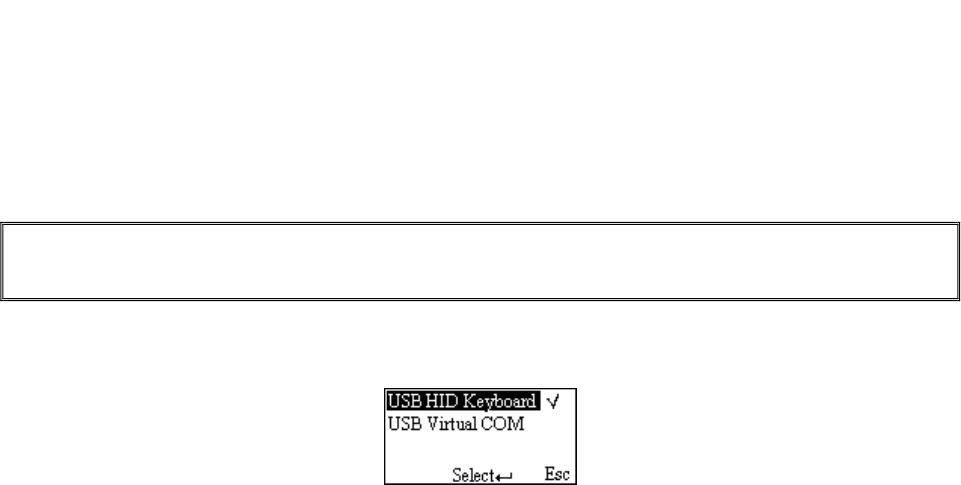
28
Step6. The BA2118 connected to the scanner is labeled √.
Step7. If you want to disconnect the BA2118 connected successfully before, you can press Scan/Select
Key to disconnect it.
5-3-6 Configure the profile of BA2118
Note: Before the configuration, make sure the scanner is wireless-connected with the BA2118
successfully.
Step1. Press Left Soft Key to the window below.
Step2. Use Navigation Key to move the cursor and press Scan/Select Key to select items.
USB HID Keyboard
Various keyboard layouts are supported.
5-4 System Setting - General
----------------------------------------------------------------------------------------------------------------------
Language
This option is used to select a language for menu display.
----------------------------------------------------------------------------------------------------------------------
Beeper volume
This option is used to control the beeper volume.
----------------------------------------------------------------------------------------------------------------------
Vibrator
This option is used to turn on/off the vibrator indicator of a good read.
----------------------------------------------------------------------------------------------------------------------
Backlight timeout
The scanner will switch off the backlight if time of no operation exceeds Backlight timeout.
----------------------------------------------------------------------------------------------------------------------
Sleeping timeout
The scanner will enter sleep mode if time of no operation exceeds Sleeping timeout. User can set the
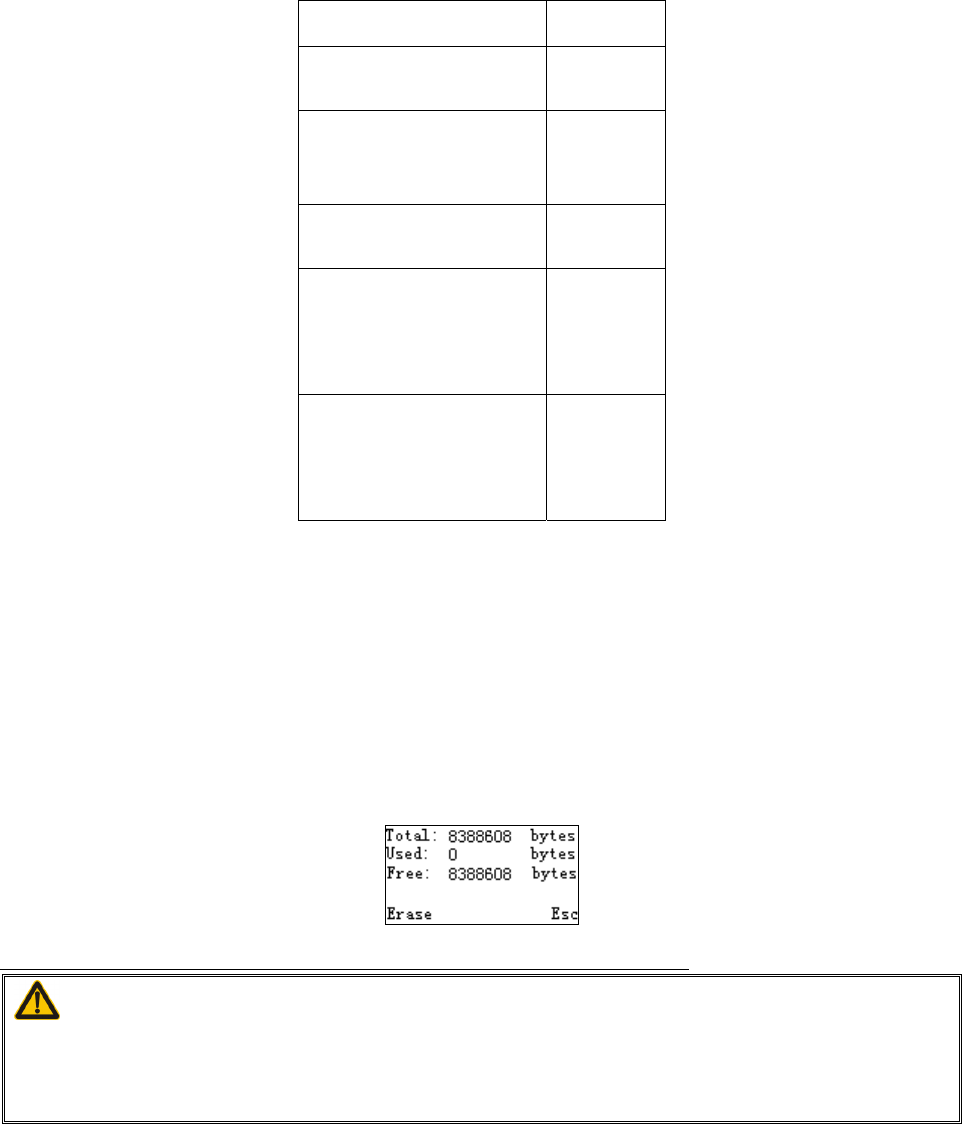
29
scanner to sleep mode by press Power/Sleep key (see Enter/exit sleep mode and power on/off
Bluetooth).
----------------------------------------------------------------------------------------------------------------------
Default setting
All parameters of the scanner return to default setting.
Table 1 General system setting
Items Option
Language English*
Chinese
Beeper volume
Low
Middle
High*
Vibrator Disable
Enable*
Backlight timeout
10s
30s*
60s
Off
Sleeping timeout
1min
5min*
10min
Off
5-5 System Information
----------------------------------------------------------------------------------------------------------------------
View Memory
User can view the used and remain memory capacity in Batch Mode.
Note: User can press Left Soft Key to erase data to release used memory.
Caution:
1. Erasing operation will delete all data in the memory.
2. Erasing operation is not undoable.
----------------------------------------------------------------------------------------------------------------------
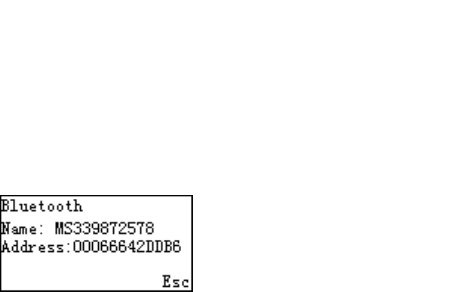
30
Bluetooth Module
User can view the name and address of the Bluetooth module.
Example:
----------------------------------------------------------------------------------------------------------------------
Firmware Version
User can view the firmware version of the scanner, scan engine, and Bluetooth module.
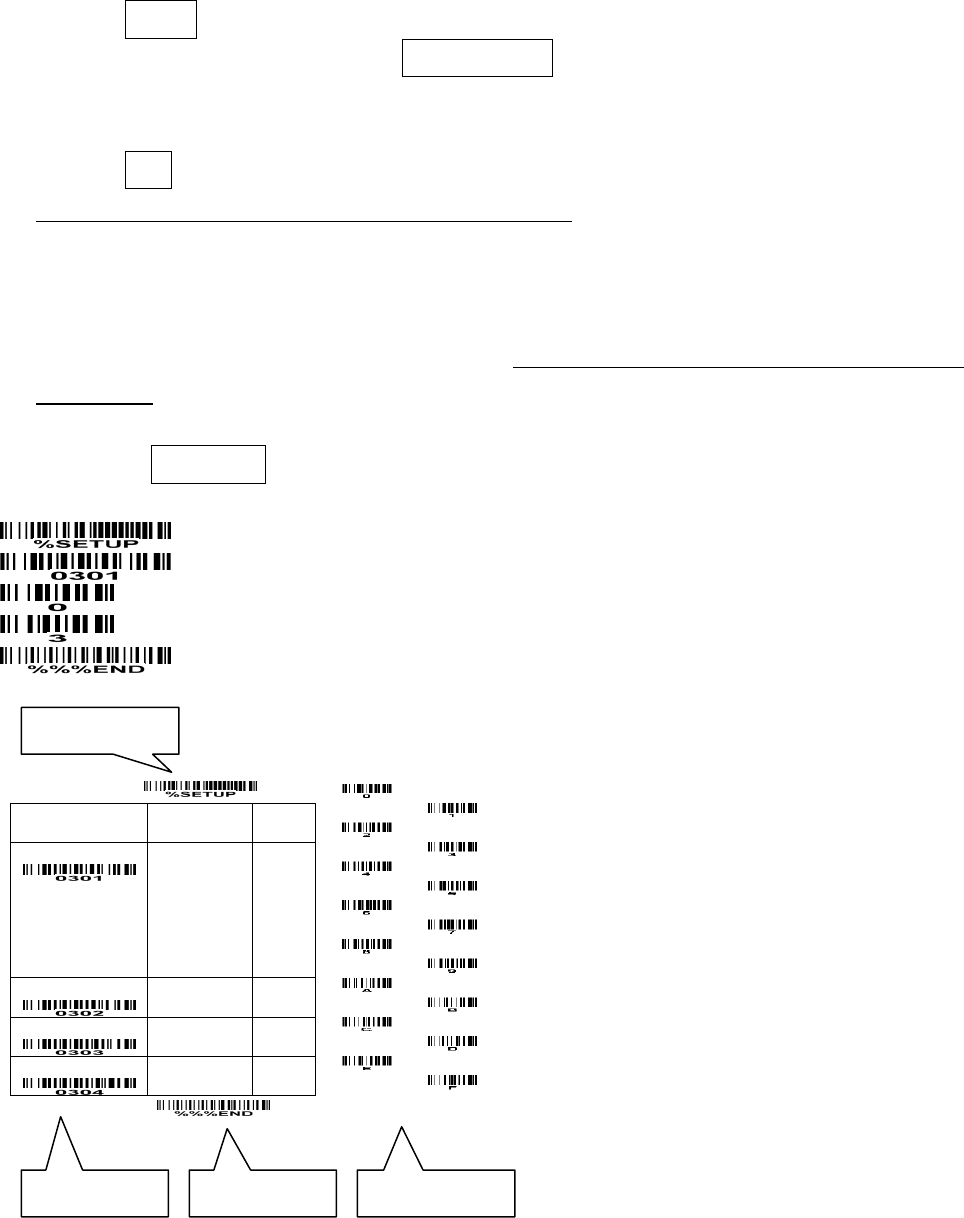
31
6 Barcode programming instructions
Programming instruction
Refer to the next page, the steps of programming are:
1. Scan the SETUP bar code on the parameter setting part.
2. Enter the option mode by scanning the Option bar code.
3. To the right of the option barcode, the necessary alphanumeric inputs are listed. Scan these
alphanumeric entries.
4. Scan the END bar code, listed on the lower right hand corner of each parameter setting part.
5. Notes that only one parameter can be setup at each time.
6. During the process of programming, LED is lighting to indicate the programming correctness. LED
will go off if any incorrect programming operation performed.
7. After each successful programming, LED will go off and the scanner will beep twice.
8. Throughout the programming bar code menus, the factory default settings are indicated with
asterisks (*).
Example: to set Flow control to be XON/XOFF.
Steps: Scan the following barcodes in order.
SETUP
Option bar code Option Alpha.
entry
Flow control
None
RTS/CTS
(Host: Low RTS)
RTS/CTS
(Host: High RTS)
XON/XOFF
ACK/NAK
00*
01
02
03
04
Inter-character delay
00-99 (ms)
00-99
00*
Block trans. delay
00-99 (10 ms)
00-99
00*
Response delay
00-99 (100 ms)
00-99
00*
END
SETUP bar code
Alpha. entries
Option bar code END bar code
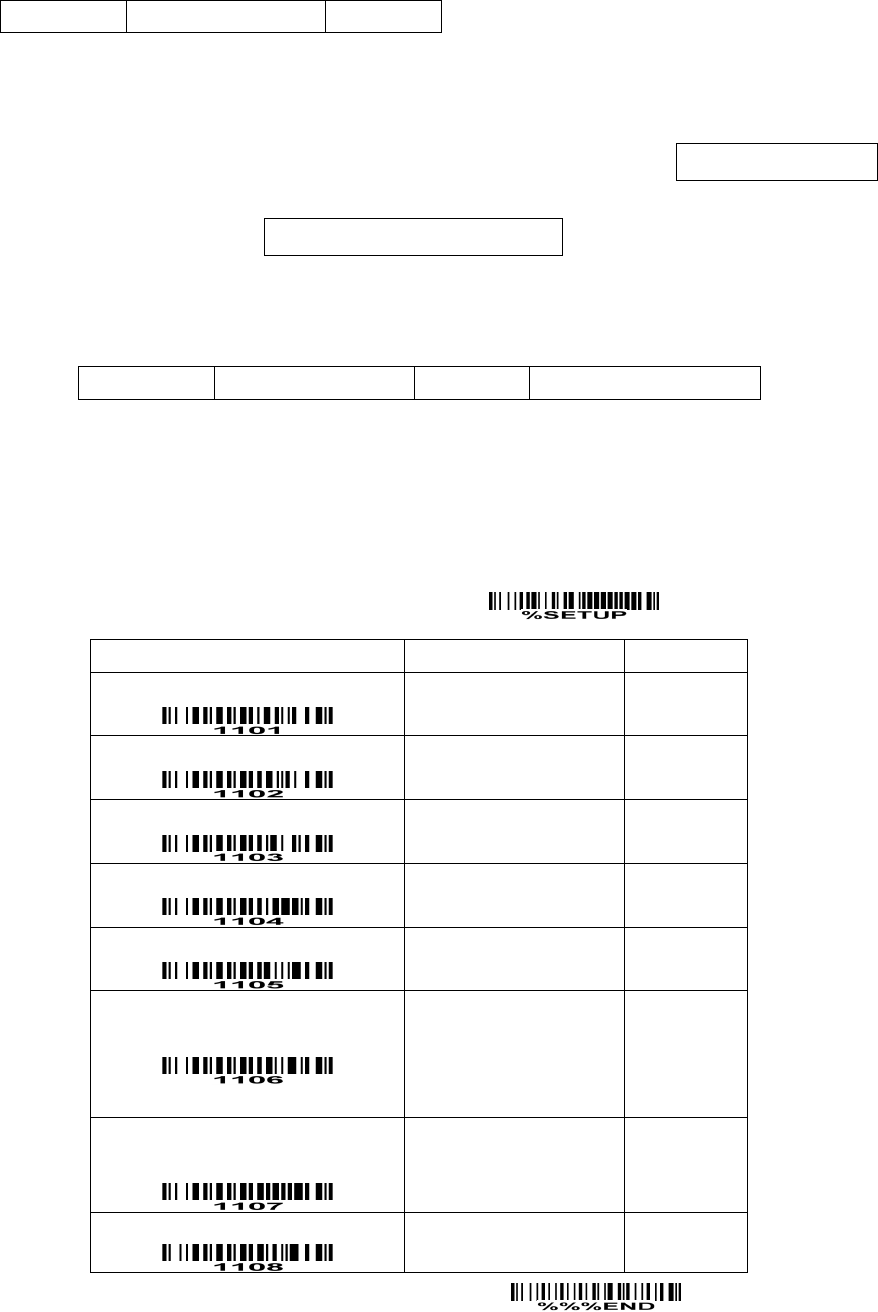
32
UPC-A
Read: Format
Leading zero Data digits (11 digits) Check digit
Check digit verification: The check digit is optional.
Check digit trans.: By setting Enable, check digit will be transmitted.
Code ID setting: Code ID is a one-or-two-character string used to represent the symbol upon a
succeeding reading. If you want application to transmit Code ID, you must set Code ID transmission to
be enabled. Refer to the chapter of String transmission.
Insertion group selection: Refer to Global insertion group selection of the chapter of Hand-held scan &
some global settings.
Supplement digits: The Supplement digits barcode is the supplemental 2 or 5 characters.
Format
Leading zero Data digits (11 digits) Check digit Supplement digits 2 or 5
Truncation/Expansion:
Truncate leading zeros- The leading “0” digits of UPC-A data characters can be truncated when the
feature is enabled.
Expand to EAN-13- It extends to 13-digits with a “0” leading digit when the feature is enabled.
SETUP
Option bar code Option Alpha. entry
Read
Disable
Enable
00
01*
Check digit verification
Disable
Enable
00
01*
Check digit trans.
Disable
Enable
00
01*
Code ID setting
00-FF16
(ASCII)
00-FF16
<A>*
Insert group selection
00-66
00-66
00*
Supplement digits
None
2 digits
5 digits
2 or 5 digits
00*
01
02
03
Truncation/Expansion
None
Truncate leading zeros
Expand to EAN-13
00*
01
02
Reserved
END
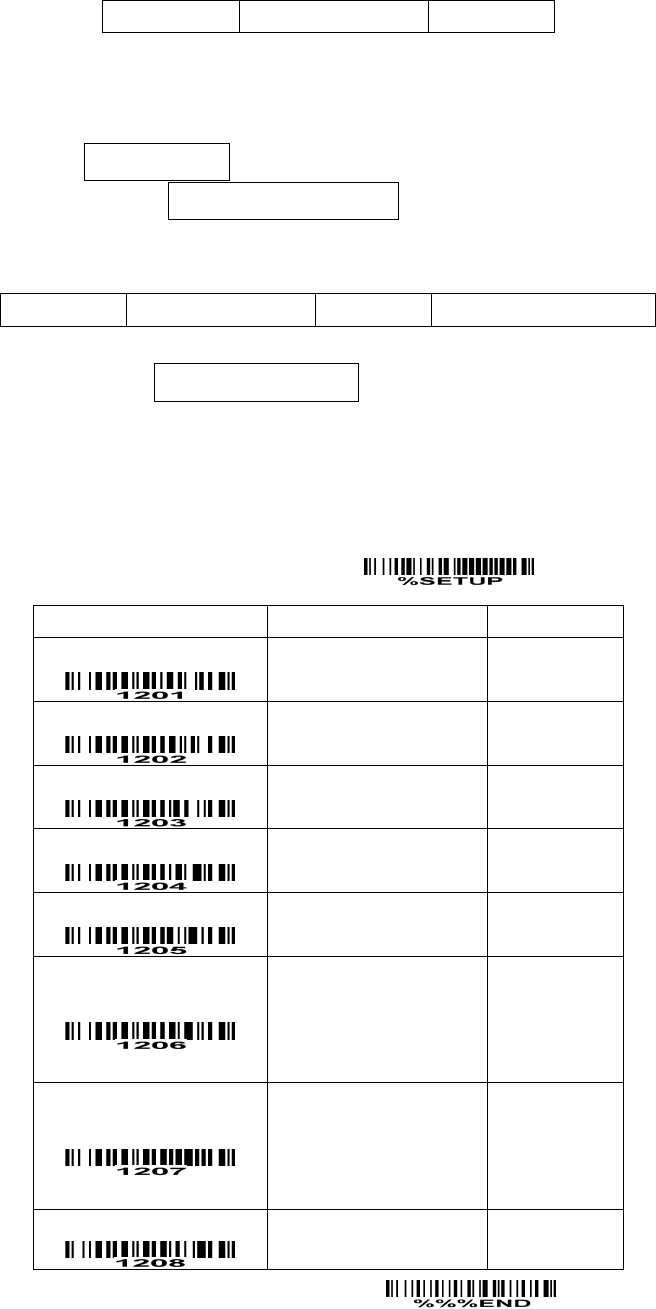
33
UPC-E
Read: Format
Leading zero Data digits (6 digits) Check digits
Check digit verification: The check digit is optional and made as the sum of the numerical value of the
data digits.
Check digit trans.: By setting Enable, check digit will be transmitted.
Code ID setting: Refer to Code ID setting of UPC-A.
Insertion group selection: Refer to Insertion group selection of UPC-A.
Supplement digits:
Format
Leading zero Data digits (6 digits) Check digit Supplement digits 2 or 5
Truncation/Expansion:
Truncate leading zeros- Refer to Truncation/Expansion of UPC-A.
Expand to EAN-13- It extends to 13-digits with “0” digits when the feature is set to be enabled.
Example: Barcode “0123654”,
Output: “0012360000057”.
Expand to UPC-A- It extends to 12-digits when the feature is set to be enabled.
SETUP
Option bar code Option Alpha. entry
Read
Disable
Enable
00
01*
Check digit verification
Disable
Enable
00
01*
Check digit trans.
Disable
Enable
00
01*
Code ID setting
00-FF16
(ASCII)
00-FF16
<D>*
Insert group selection
00-66
00-66
00*
Supplement digits
None
2 digits
5 digits
2 or 5 digits
00*
01
02
03
Truncation/Expansion
None
Truncate leading zeros
Expand to EAN-13
Expand to UPC-A
00*
01
02
03
Reserved
END
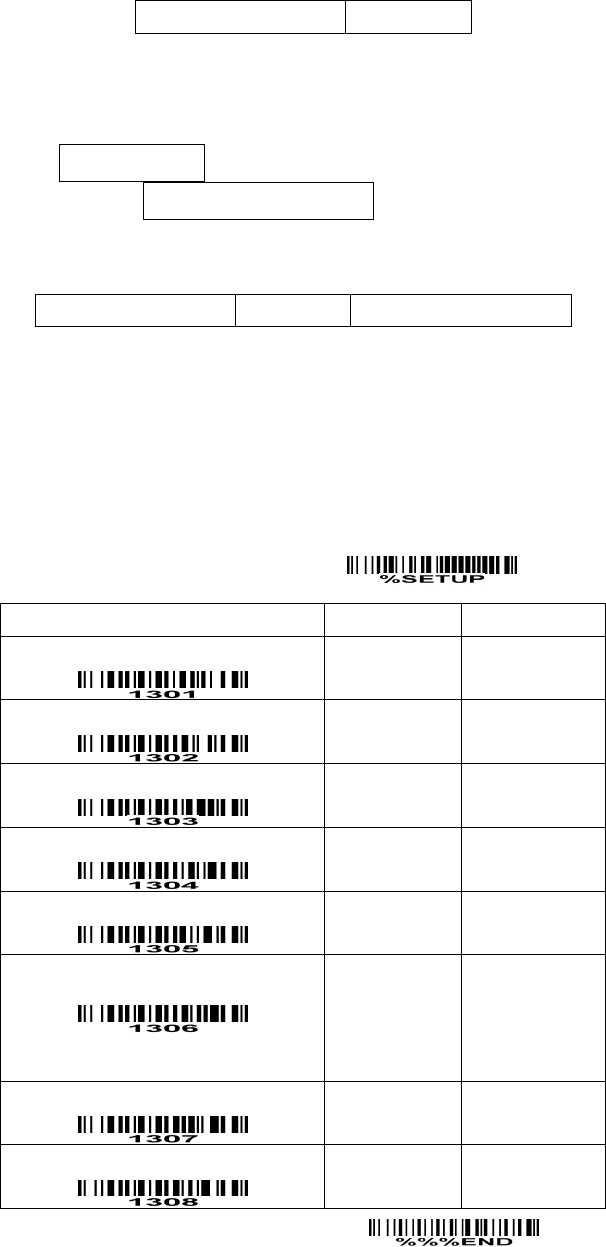
34
EAN-13
Read:
Format
Data digits (12 digits) Check digit
Check digit verification: The check digit is optional and made as the sum of the numerical value of the
data digits.
Check digit transmission: By setting Enable, check digit will be transmitted.
Code ID setting: Refer to Code ID setting of UPC-A.
Insertion group selection: Refer to Insertion group selection of UPC-A.
Supplement digits:
Format
Data digits (12 digits) Check digit Supplement digits 2 or 5
ISBN/ISSN: The ISBN (International Standard Book Number) and ISSN (International Standard Serial
Number) are two kinds of barcode for books and magazines. The ISBN is 10 digits with leading “978”
and the ISSN is 8 digits with leading “977” of the EAN-13 symbology.
Example:
Barcode “9780194315104”, Output: “019431510X”.
Barcode “9771005180004”, Output: “10051805”.
SETUP
Option bar code Option Alpha. entry
Read
Disable
Enable
00
01*
Check digit verification
Disable
Enable
00
01*
Check digit transmission
Disable
Enable
00
01*
Code ID setting
00-FF16
(ASCII)
00-FF16
<A>*
Insert group selection
00-66
00-66
00*
Supplement digits
None
2 digits
5 digits
2 or 5 digits
00*
01
02
03
ISBN/ISSN conversion
Disable
Enable
00*
01
Reserved
END
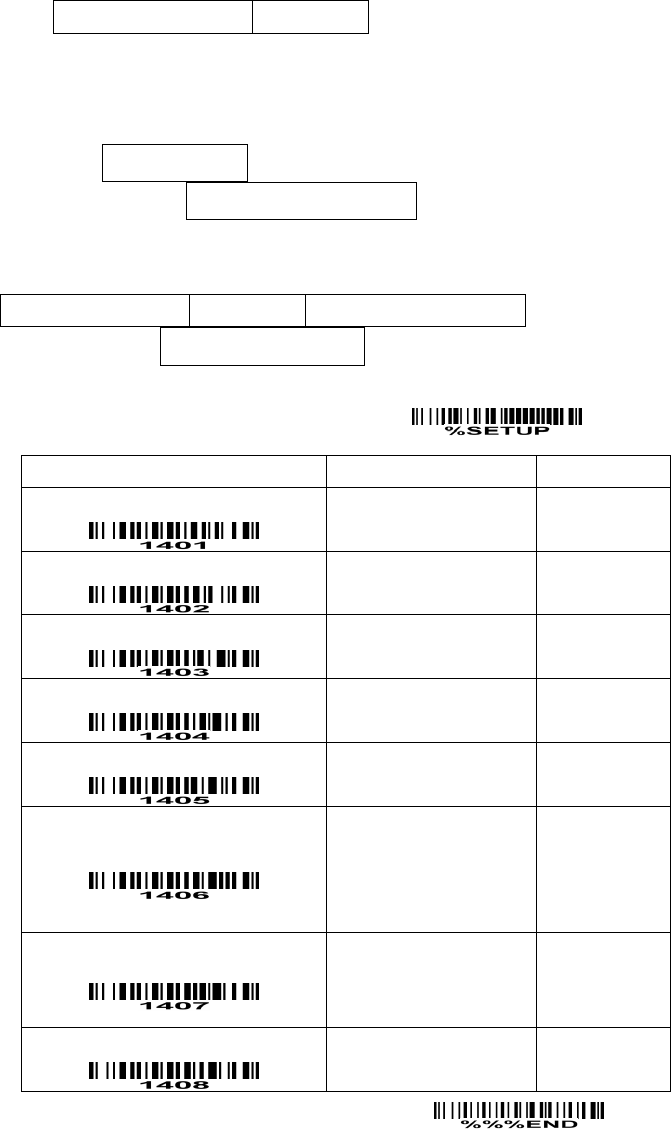
35
EAN-8
Read:
Format
Data digits (7 digits) Check digit
Check digit verification: The check digit is optional and made as the sum of the numerical value of the
data digits.
Check digit trans.: By setting Enable, check digit will be transmitted.
Code ID setting: Refer to Code ID setting of UPC-A.
Insertion group selection: Refer to Insertion group selection of UPC-A.
Supplement digits:
Format
Data digits (7 digits) Check digit Supplement Digits 2 or 5
Truncation/Expansion: Refer to Truncation/Expansion of UPC-A.
SETUP
Option bar code Option Alpha. entry
Read
Disable
Enable
00
01*
Check digit verification
Disable
Enable
00
01*
Check digit trans.
Disable
Enable
00
01*
Code ID setting
00-FF16
(ASCII)
00-FF16
<A>*
Insert group selection
00-66
00-66
00*
Supplement digits
None
2 digits
5 digits
2 or 5 digits
00*
01
02
03
Truncation/Expansion
None
Truncate leading zero
Expand to EAN-13
00*
01
02
Reserved
END
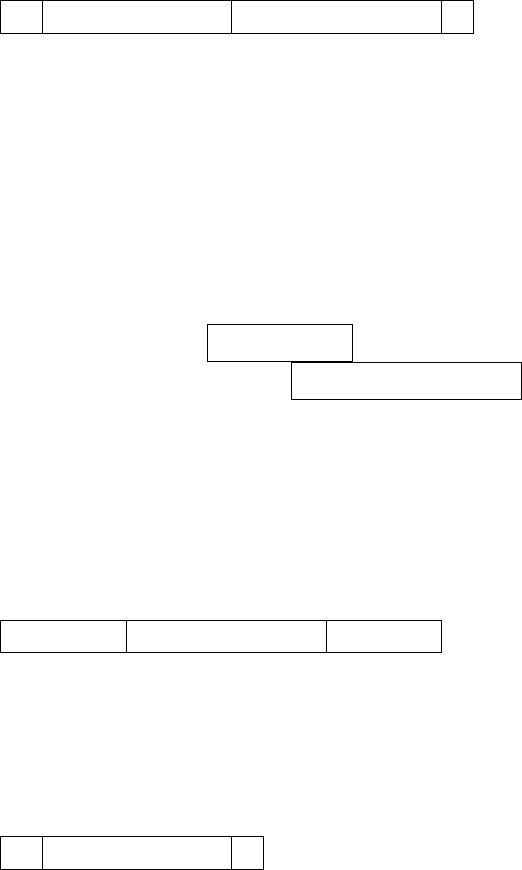
36
Code 39
Read:
Format
⋆ Data digits (variable) Check digit (optional) ⋆
Check digit verification: The check digit is optional and made as the sum module 43 of the numerical
value of the data digits.
Check digit transmission: By setting Enable, check digit will be transmitted.
Max./Min. code length: Each symbology has own max./min. code length. If both setting of max./min.
code length are “00”s, the setting of global max./min. code length is effective. The length is defined as
to the actual barcode data length to be sent. Label with length exceeds these limits will be rejected.
Make sure that the minimum length setting is no greater than the maximum length setting, or otherwise
all the labels of the symbology will not be readable. In particular, you can see the same value for both
minimum and maximum reading length to force the fixed length barcode decoded.
Code ID setting: Refer to Code ID setting of UPC-A.
Insertion group selection: Refer to Insertion group selection of UPC-A.
Start/End transmission: The start and end characters of Code 39 are “⋆”s. You can transmit all data
digits including two “⋆”s.
“⋆” as data character: By setting Enable, “⋆” can be recognized as data character.
Convert Code 39 to Code 32: Code 32 is a variant of Code 39 used by the Italian pharmaceutical
industry. Note that Code 39 must be enabled in order for this parameter to function.
Format of Code 32
“A” (optional) Data digits (8 digits) Check digit
Code 32 Prefix “A” transmission: By setting Enable, the prefix character “A” can be added to all Code 32
barcodes.
Trioptic Code 39 read: Trioptic Code 39 is a variant of Code 39 used in the marking of magnetic tapes
and computer cartridges. Trioptic Code 39 symbols always contain six characters.
Format
$ Data digits (6 digits) $
Trioptic Code 39 Start/End transmission: The start and end characters of Trioptic Code 39 are “$”s.
You can transmit all data digits including two “$”s.
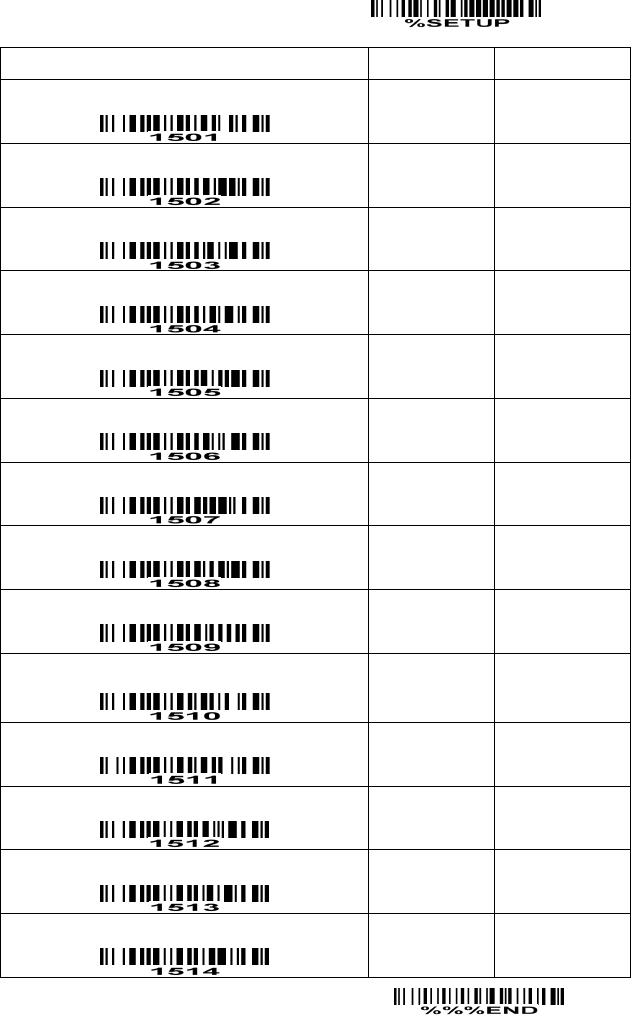
37
SETUP
Option bar code Option Alpha. entry
Read
Disable
Enable
00
01*
Check digit verification
Disable
Enable
00*
01
Check digit transmission
Disable
Enable
00*
01
Max. code length
00-99
00-99
00*
Min. code length
00-99
00-99
01*
Code ID setting
00-FF16
(ASCII)
00-FF16
<M>*
Insert group selection
00-66
00-66
00*
Format
Standard
Full ASCII
00*
01
Start/End transmission
Disable
Enable
00*
01
“⋆” as data character
Disable
Enable
00*
01
Convert Code 39 to Code 32
Disable
Enable
00*
01
Code 32 Prefix “A” transmission
Disable
Enable
00*
01
Trioptic Code 39 read
Disable
Enable
00*
01
Trioptic Code 39 Start/End transmission
Disable
Enable
00*
01
END
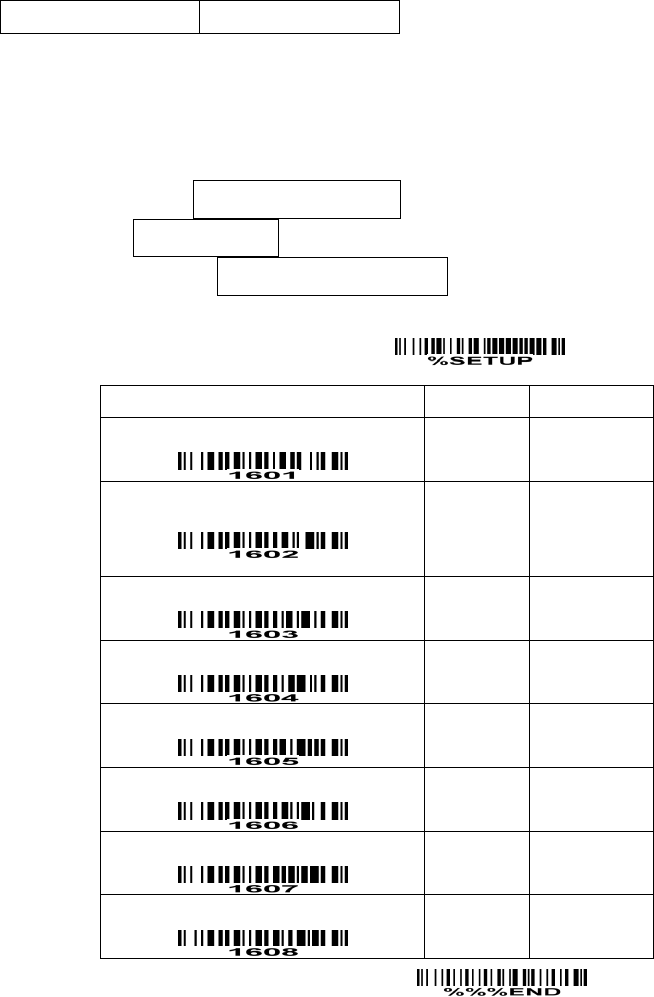
38
Interleaved 2 of 5
Read:
Format
Data digits (Variable) Check digit (optional)
Check digit verification: The check digit is made as the sum module 10 of the numerical values of all data
digits. There are two optional check digit algorithms: the specified Uniform Symbology Specification
(USS) and the Optical Product Code Council (OPCC).
Check digit transmission: By setting Enable, check digit will be transmitted.
Max./Min. code length: Refer to Max./Min. code length of Code 39.
Code ID setting: Refer to Code ID setting of UPC-A.
Insertion group selection: Refer to Insertion group selection of UPC-A.
SETUP
Option bar code Option Alpha. entry
Read
Disable
Enable
00
01*
Check digit verification
Disable
USS
OPCC
00*
01
02
Check digit transmission
Disable
Enable
00*
01
Max. code length
00-99
00-99
00*
Min. code length
00-99
00-99
06*
Code ID setting
00-FF16
(ASCII)
00-FF16
<I>*
Insert group selection
00-66
00-66
00*
Reserved
END
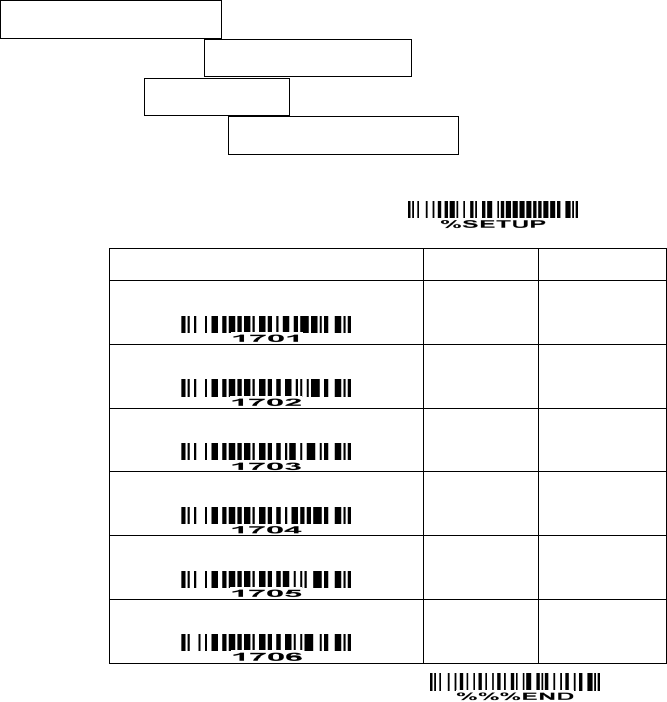
39
Industrial 2 of 5
Read:
Format
Data digits (variable)
Max./Min. code length: Refer to Max./Min. code length of Code 39.
Code ID setting: Refer to Code ID setting of UPC-A.
Insertion group selection: Refer to Insertion group selection of UPC-A.
SETUP
Option bar code Option Alpha. entry
Read
Disable
Enable
00*
01
Max. code length
00-99
00-99
00*
Min. code length
00-99
00-99
00*
Code ID setting
00-FF16
(ASCII)
00-FF16
<H>*
Insert group selection
00-66
00-66
00*
Reserved
END
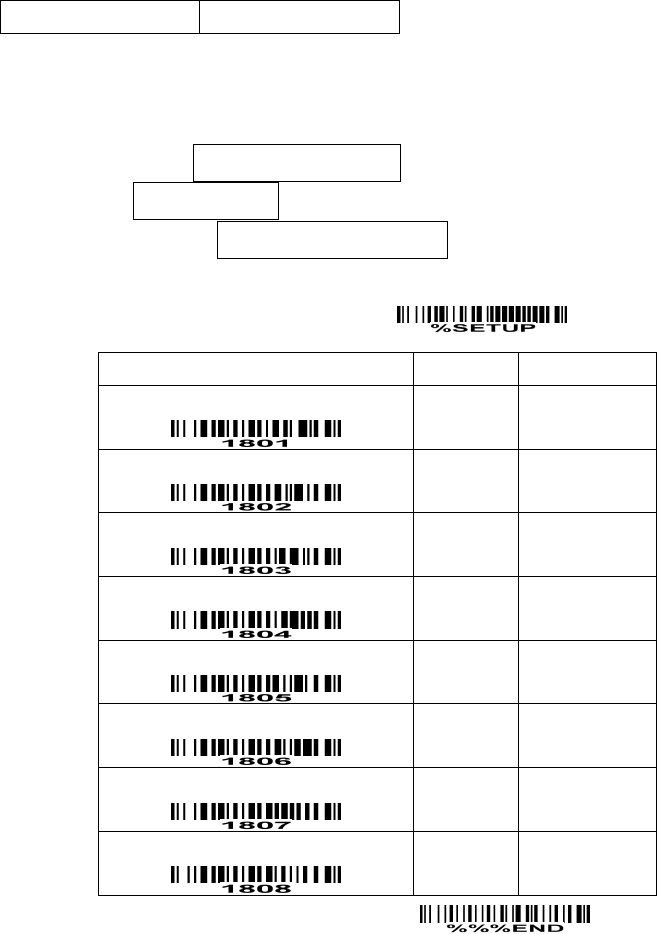
40
Matrix 2 of 5
Read:
Format
Data digits (variable) Check digit (optional)
Check digit verification: The check digit is made as the sum module 10 of the numerical values of all data
digits.
Check digit transmission: By setting Enable, check digit will be transmitted.
Max./Min. code length: Refer to Max./Min. code length of Code 39.
Code ID setting: Refer to Code ID setting of UPC-A.
Insertion group selection: Refer to Insertion group selection of UPC-A.
SETUP
Option bar code Option Alpha. entry
Read
Disable
Enable
00
01*
Check digit verification
Disable
Enable
00*
01
Check digit transmission
Disable
Enable
00*
01
Max. code length
00-99
00-99
00*
Min. code length
00-99
00-99
06*
Code ID setting
00-FF16
(ASCII)
00-FF16
<X>*
Insert group selection
00-44
00-44
00*
Reserved
END
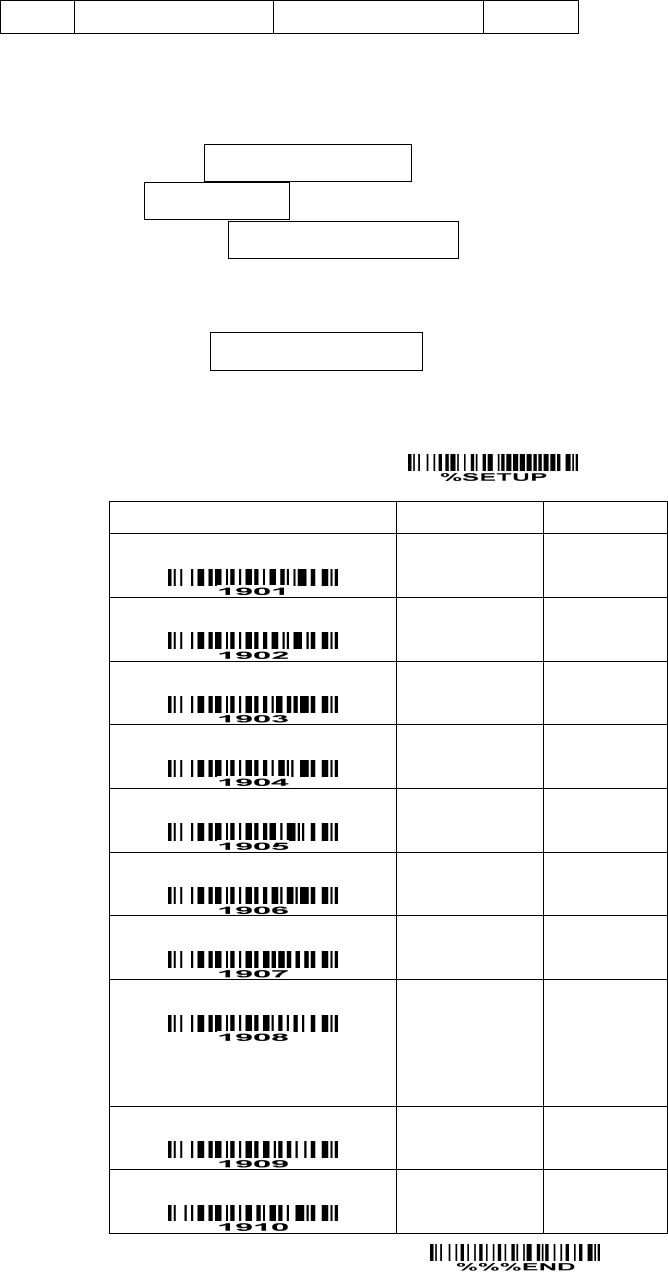
41
Codabar
Read:
Format
Start Data digits (variable) Check digit (optional) End
Check digit verification: The check digit is made as the sum module 16 of the numerical values of all data
digits.
Check digit transmission: By setting Enable, check digit will be transmitted.
Max./Min. code length: Refer to Max./Min. code length of Code 39.
Code ID setting: Refer to Code ID setting of UPC-A.
Insertion group selection: Refer to Insertion group selection of UPC-A.
Start/End type: Codabar has four pairs of Start/End pattern; you may select one pair to match your
application.
Start/End transmission: Refer to Start/End transmission of Code 39.
Start/End character equality: By setting Enable, the start and end character of a Codabar barcode must
be the same.
SETUP
Option bar code Option Alpha. entry
Read
Disable
Enable
00
01*
Check digit verification
Disable
Enable
00*
01
Check digit transmission
Disable
Enable
00*
01
Max. code length
00-99
00-99
00*
Min. code length
00-99
00-99
00*
Code ID setting
00-FF16
(ASCII)
00-FF16
<N>*
Insert group selection
00-66
00-66
00*
Start/End type
ABCD/ABCD
abcd/abcd
ABCD/TN⋆E
abcd/tn⋆e
00*
01
02
03
Start/End transmission
Disable
Enable
00*
01
Start/End character equality
Disable
Enable
00*
01
END
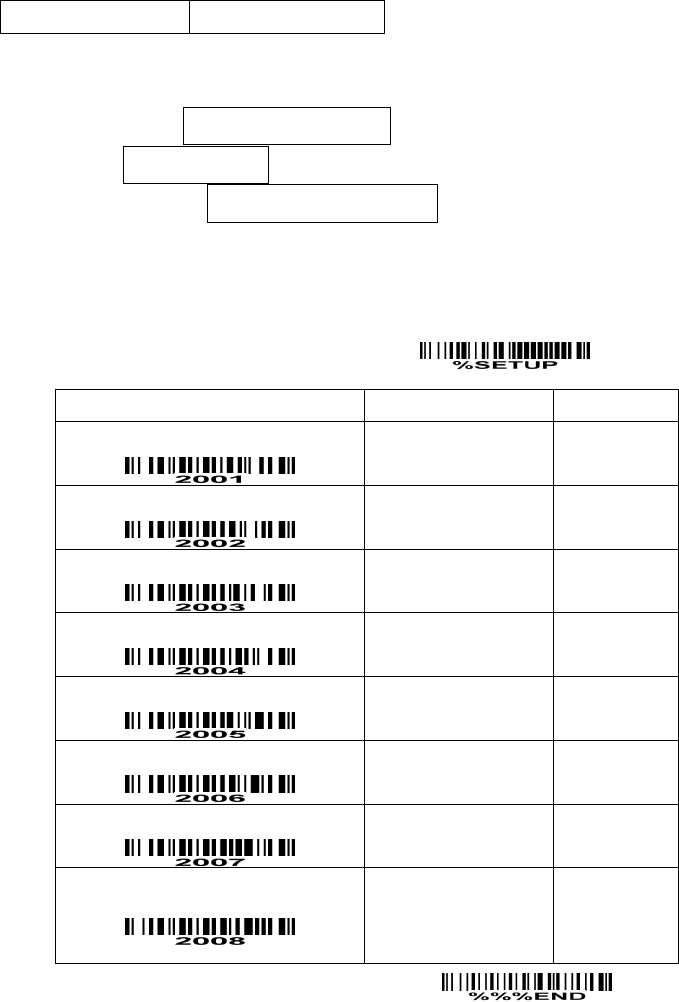
42
Code 128
Read:
Format
Data digits (variable) Check digit (optional)
Check digit verification: The check digit is made as the sum module 103 of all data digits.
Check digit transmission: By setting Enable, check digit will be transmitted.
Max./Min. code length: Refer to Max./Min. code length of Code 39.
Code ID setting: Refer to Code ID setting of UPC-A.
Insertion group selection: Refer to Insertion group selection of UPC-A.
Truncate leading zeros: The leading “0” digits of Code 128 barcode characters can be truncated when
the feature is enabled.
SETUP
Option bar code Option Alpha. entry
Read
Disable
Enable
00
01*
Check digit verification
Disable
Enable
00
01*
Check digit transmission
Disable
Reserved
00*
01
Max. code length
00-99
00-99
00*
Min. code length
00-99
00-99
01*
Code ID setting
00-FF16
(ASCII)
00-FF16
<K>*
Insert group selection
00-66
00-66
00*
Truncate leading zeros
Disable
All leading “0”s
Only the first “0”
00*
01
02
END
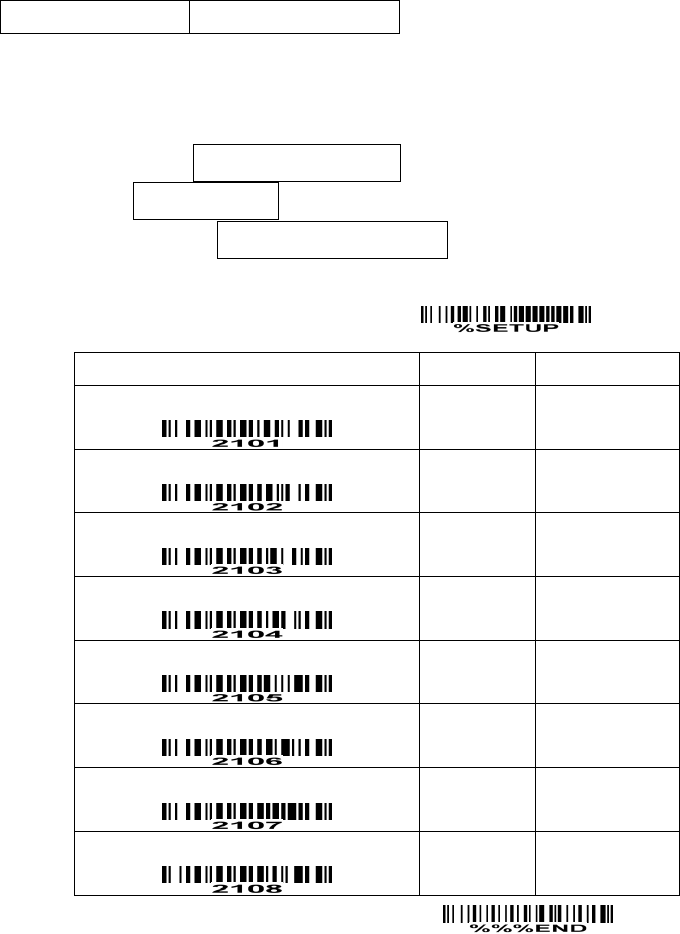
43
Code 93
Read:
Format
Data digits (variable) 2 check digits (optional)
Check digit verification: The check digit is made as the sum module 47 of the numerical values of all data
digits.
Check digit transmission: By setting Enable, check digit will be transmitted.
Max./Min. code length: Refer to Max./Min. code length of Code 39.
Code ID setting: Refer to Code ID setting of UPC-A.
Insertion group selection: Refer to Insertion group selection of UPC-A.
SETUP
Option bar code Option Alpha. entry
Read
Disable
Enable
00
01*
Check digit verification
Disable
Enable
00
01*
Check digit transmission
Disable
Enable
00*
01
Max. code length
00-99
00-99
00*
Min. code length
00-99
00-99
01*
Code ID setting
00-FF16
(ASCII)
00-FF16
<L>*
Insert group selection
00-66
00-66
00*
Reserved
END
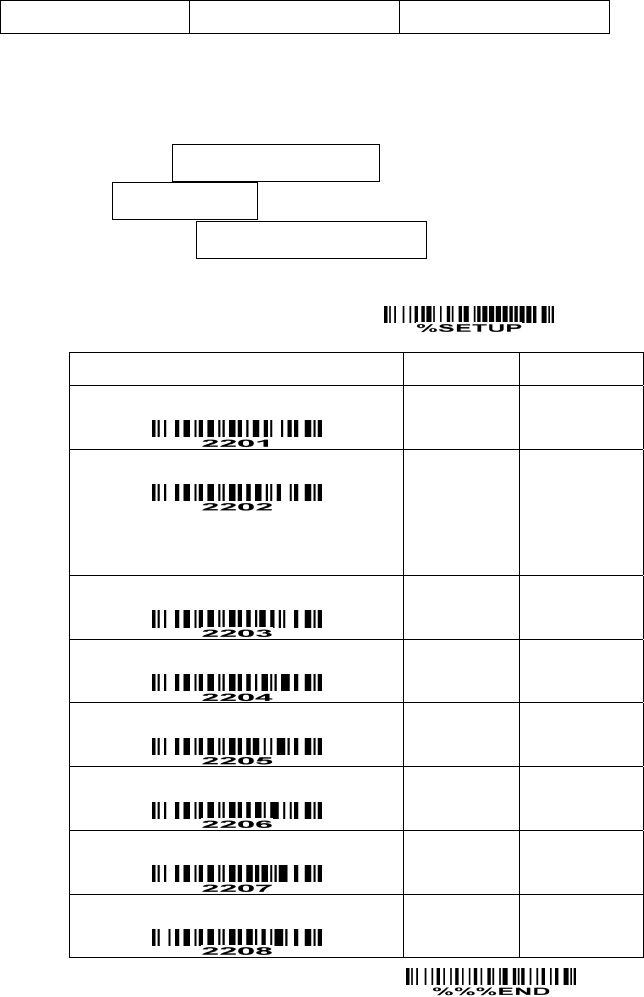
44
Code 11
Read:
Format
Data digits (variable) Check digit 1 (optional ) Check digit 2 (optional)
Check digit verification: The check digit is presented as the sum module 11 of all data digits.
Check digit transmission: By setting Enable, check digit 1 and check digit 2 will be transmitted upon your
selected check digit verification method.
Max./Min. code length: Refer to Max./Min. code length of Code 39.
Code ID setting: Refer to Code ID setting of UPC-A.
Insertion group selection: Refer to Insertion group selection of UPC-A.
SETUP
Option bar code Option Alpha. entry
Read
Disable
Enable
00*
01
Check digit verification
Disable
One digit
Reserved
Reserved
00
01*
02
03
Check digit transmission
Disable
Enable
00*
01
Max. code length
00-99
00-99
00*
Min. code length
00-99
00-99
00*
Code ID setting
00-FF16
(ASCII)
00-FF16
<V>*
Insert group selection
00-66
00-66
00*
Reserved
END
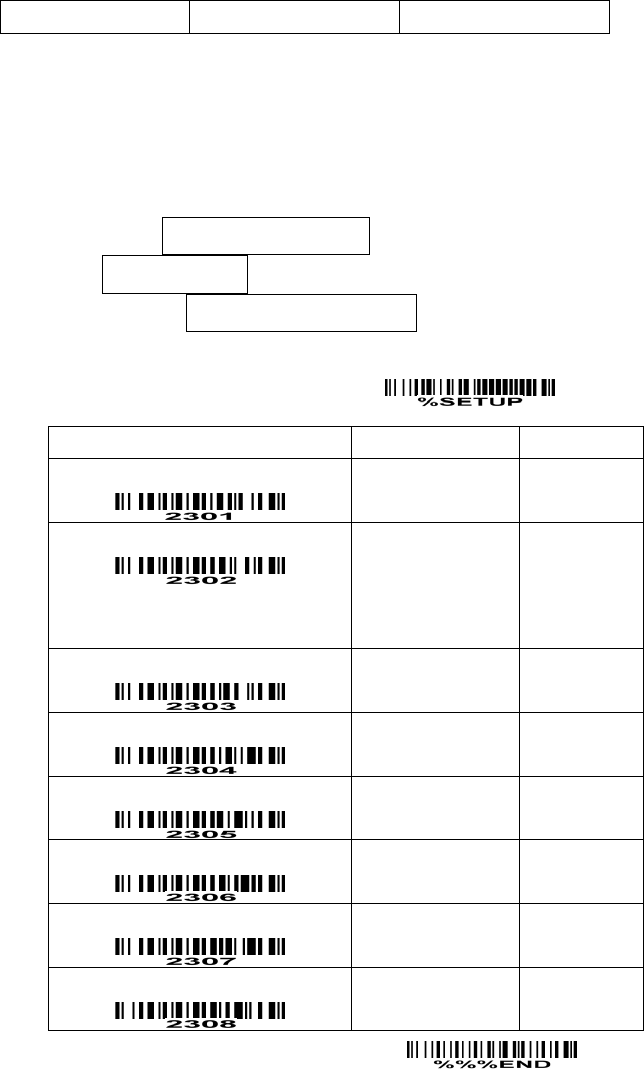
45
MSI/Plessey
Read:
Format
Data digits (variable) Check digit 1 (optional) Check digit 2 (optional)
Check digit verification: The MSI/Plessey has one or two optional check digits. There are three
methods of verifying check digits, i.e. Mod10, Mod10/10 and Mod 11/10. The check digit 1 and check
digit 2 will be calculated as the sum module 10 or 11 of the data digits.
Check digit transmission: By setting Enable, check digit 1 and check digit 2 will be transmitted upon your
selected check digit verification method.
Max./Min. code length: Refer to Max./Min. code length of Code 39.
Code ID setting: Refer to Code ID setting of UPC-A.
Insertion group selection: Refer to Insertion group selection of UPC-A.
SETUP
Option bar code Option Alpha. entry
Read
Disable
Enable
00*
01
Check digit verification
Disable
1 digit (mod 10)
Reserved
Reserved
00*
01
02
03
Check digit transmission
Disable
Enable
00*
01
Max. code length
00-99
00-99
00*
Min. code length
00-99
00-99
00*
Code ID setting
00-FF16
(ASCII)
00-FF16
<O>*
Insert group selection
00-66
00-66
00*
Reserved
END
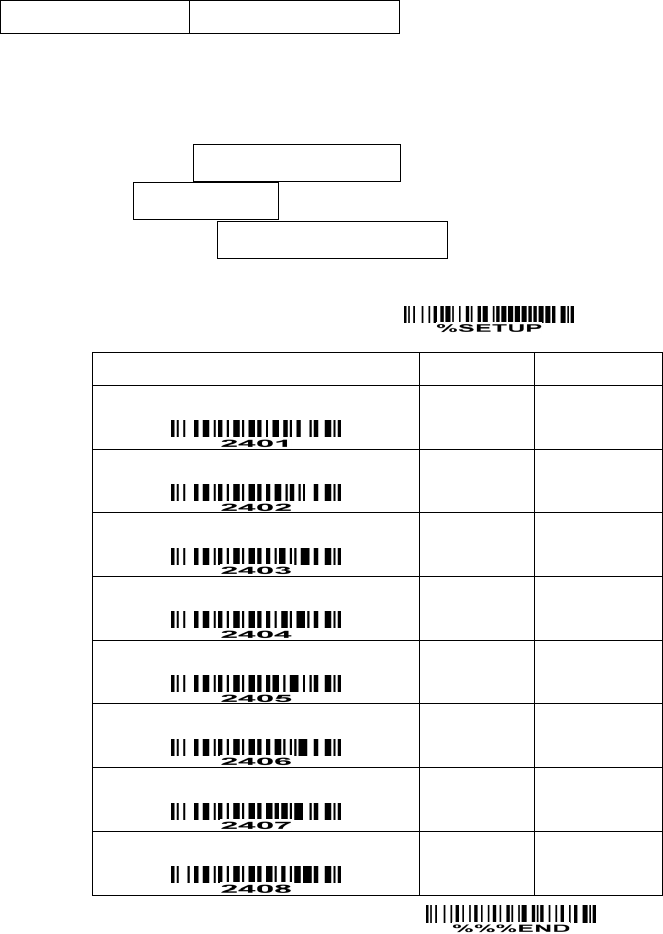
46
UK/Plessey
Read:
Format
Data digits (variable) 2 check digits (optional)
Check digit verification: The UK/Plessey has one or two optional check digits. The check digit 1 and
check digit 2 will be calculated as the sum module 10 or 11 of the data digits.
Check digit transmission: By setting Enable, check digit will be transmitted.
Max./Min. code length: Refer to Max./Min. code length of Code 39.
Code ID setting: Refer to Code ID setting of UPC-A.
Insertion group selection: Refer to Insertion group selection of UPC-A.
SETUP
Option bar code Option Alpha. entry
Read
Disable
Enable
00*
01
Check digit verification
Disable
Enable
00
01*
Check digit transmission
Disable
Enable
00*
01
Max. code length
00-99
00-99
00*
Min. code length
00-99
00-99
01*
Code ID setting
00-FF16
(ASCII)
00-FF16
<U>*
Insert group selection
00-66
00-66
00*
Reserved
END
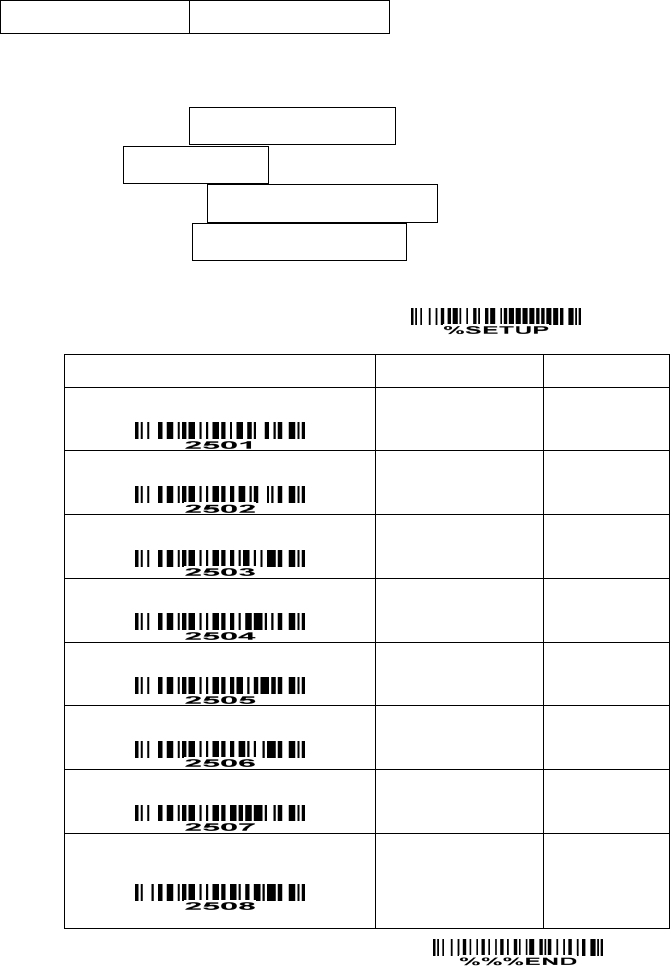
47
UCC/EAN 128
Read:
Format
Data digits (variable) Check digit (optional)
Check digit verification: The check digit is made as the sum module 103 of all data digits.
Check digit transmission: By setting Enable, check digit will be transmitted.
Max. /Min. code length: Refer to Max./Min. code length of Code 39.
Code ID setting: Refer to Code ID setting of UPC-A.
Insertion group selection: Refer to Insertion group selection of UPC-A.
Truncate leading zeros: Refer to Truncate leading zeros of Code 128.
SETUP
Option bar code Option Alpha. entry
Read
Disable
Enable
00
01*
Check digit verification
Disable
Enable
00
01*
Check digit transmission
Disable
Reserved
00*
01
Max. code length
00-99
00-99
00*
Min. code length
00-99
00-99
01*
Code ID setting
00-FF16
(ASCII)
00-FF16
<K>*
Insert group selection
00-66
00-66
00*
Truncate leading zeros
Disable
All leading “0”s
Only the first “0”
00*
01
02
END
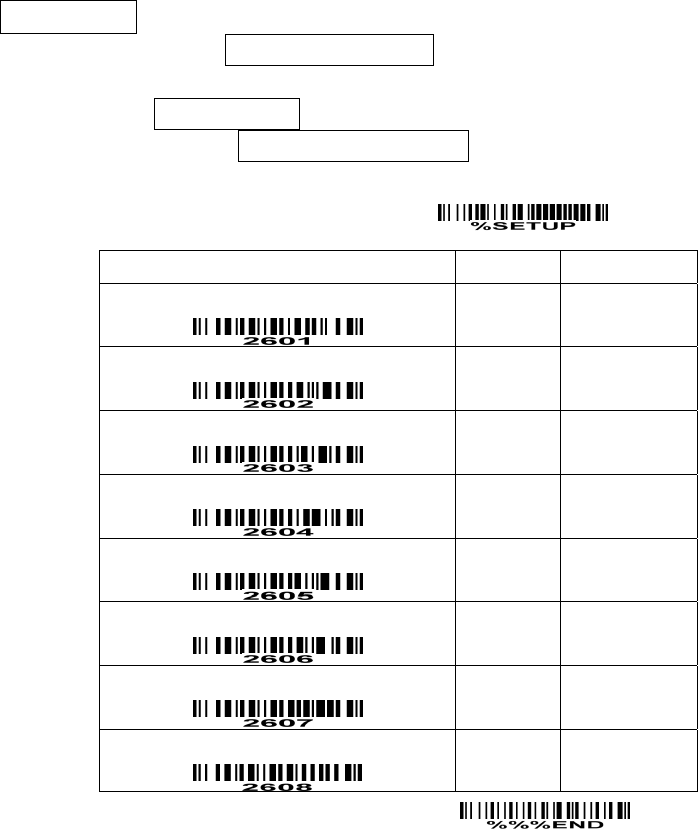
48
China Post
Read:
Format
11 Data digits
Max. /Min. code length: Refer to Max./Min. code length of Code 39. The code length of China Post is
11.
Code ID setting: Refer to Code ID setting of UPC-A.
Insertion group selection: Refer to Insertion group selection of UPC-A.
SETUP
Option bar code Option Alpha. entry
Read
Disable
Enable
00
01*
Reserved
Reserved
Max. code length
00-99
00-99
11*
Min. code length
00-99
00-99
11*
Code ID setting
00-FF16
(ASCII)
00-FF16
<T>*
Insert group selection
00-66
00-66
00*
Reserved
END
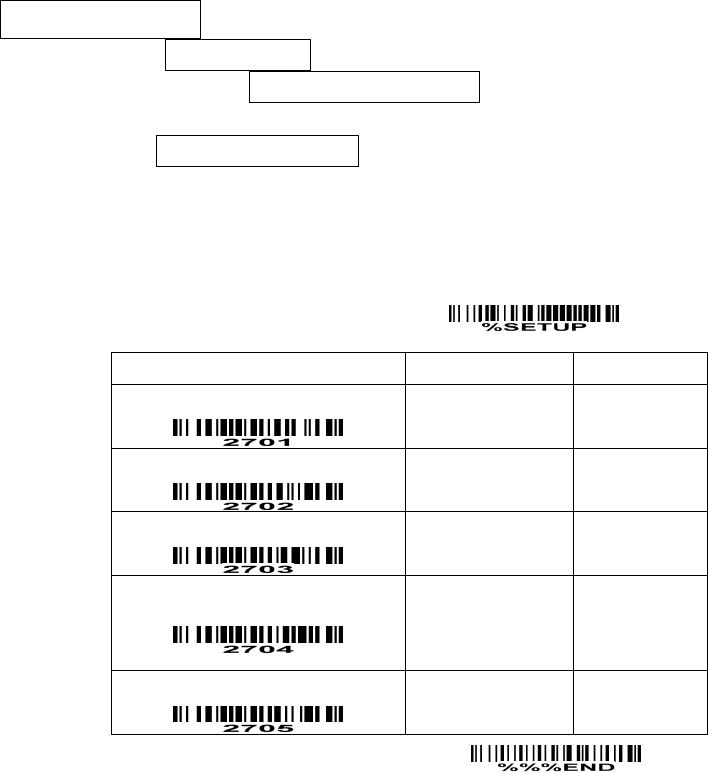
49
GS1 DataBar (GS1 DataBar Truncated)
GS1 DataBar Truncated is structured and encoded the same as the standard GS1 DataBar format,
except its height is reduced to a 13 modules minimum; while GS1 DataBar should have a height greater
than or equal to 33 modules.
Read:
Format
16 Data digits
Code ID setting: Refer to Code ID setting of UPC-A.
Insertion group selection: Refer to Insertion group selection of UPC-A.
Conversion:
UCC/EAN 128- Refer to Code ID transmission of String transmission, ]Cm will be identified as AIM ID.
UPC-A or EAN-13- Barcode beginning with a single zero as the first digit has the leading “010” stripped
and the barcode reported as EAN-13. Barcode beginning with two or more zeros but not six zeros has
the leading “0100” stripped and the barcode reported as UPC-A.
SETUP
Option bar code Option Alpha. entry
Read
Disable
Enable
00
01*
Code ID setting
00-FF16
(ASCII)
00-FF16
<R >*
Insert group selection
00-66
00-66
00*
Conversion
None
UCC/EAN 128
UPC-A or EAN-13
00*
01
02
Reserved
END

50
GS1 DataBar Limited
Read:
Format
16 Data digits
Code ID setting: Refer to Code ID setting of UPC-A.
Insertion group selection: Refer to Insertion group selection of UPC-A.
Conversion: Refer to Conversion of GS1 DataBar (GS1 DataBar Truncated).
SETUP
Option bar code Option Alpha. entry
Read
Disable
Enable
00
01*
Code ID setting
00-FF16
(ASCII)
00-FF16
<R >*
Insert group selection
00-66
00-66
00*
Conversion
None
UCC/EAN 128
UPC-A or EAN-13
00*
01
02
Reserved
END
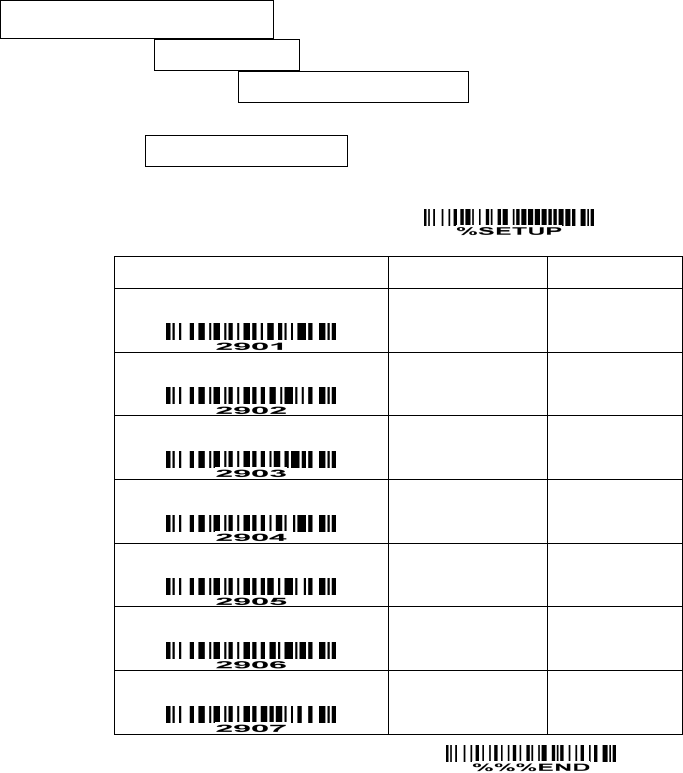
51
GS1 DataBar Expanded
Read:
Format
Data characters (variable)
Code ID setting: Refer to Code ID setting of UPC-A.
Insertion group selection: Refer to Insertion group selection of UPC-A.
Conversion:
UCC/EAN 128- Refer to Code ID transmission of String transmission, ]Cm will be identified as AIM ID.
SETUP
Option bar code Option Alpha. entry
Read
Disable
Enable
00
01*
Max. code length
00-99
00-99
00*
Min. code length
00-99
00-99
01*
Code ID setting
00-FF16
(ASCII)
00-FF16
<R >*
Insert group selection
00-66
00-66
00*
Conversion
None
UCC/EAN 128
00*
01
Reserved
END
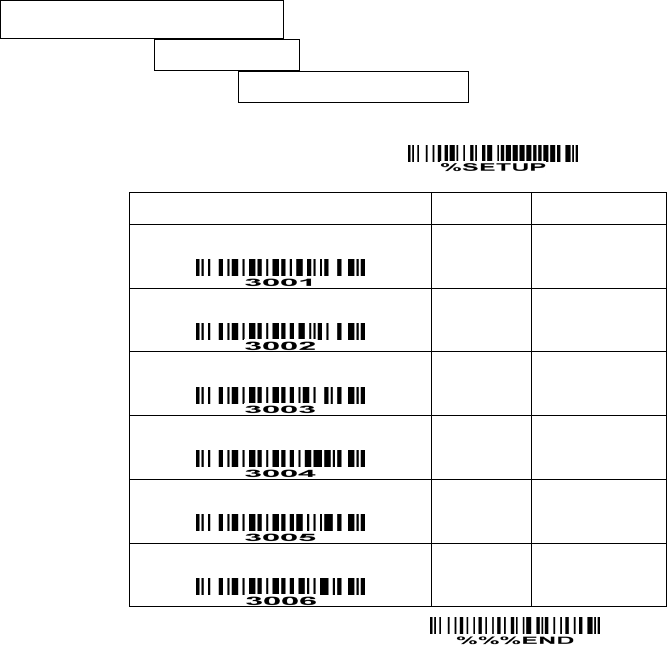
52
PDF417
This decoder is only applied with a specified firmware.
The symbol size in the standard of PDF417 says, number of rows: 3 to 90, and number of columns: 1 to
30. This scanner can only decode PDF417 at rows from 3 to 40 and columns from 1 to 20.
The error correction level for a PDF417 symbol is from 0 to 8. This scanner can only support the levels
from 0 to 6.
Read:
Format
Data characters (variable)
Code ID setting: Refer to Code ID setting of UPC-A.
Insertion group selection: Refer to Insertion group selection of UPC-A.
SETUP
Option bar code Option Alpha. entry
Read
Disable
Enable
00*
01
Max. code length
00-99
00-99
00*
Min. code length
00-99
00-99
01*
Code ID setting
00-FF16
(ASCII)
00-FF16
<P>*
Insert group selection
00-66
00-66
00*
Reserved
END
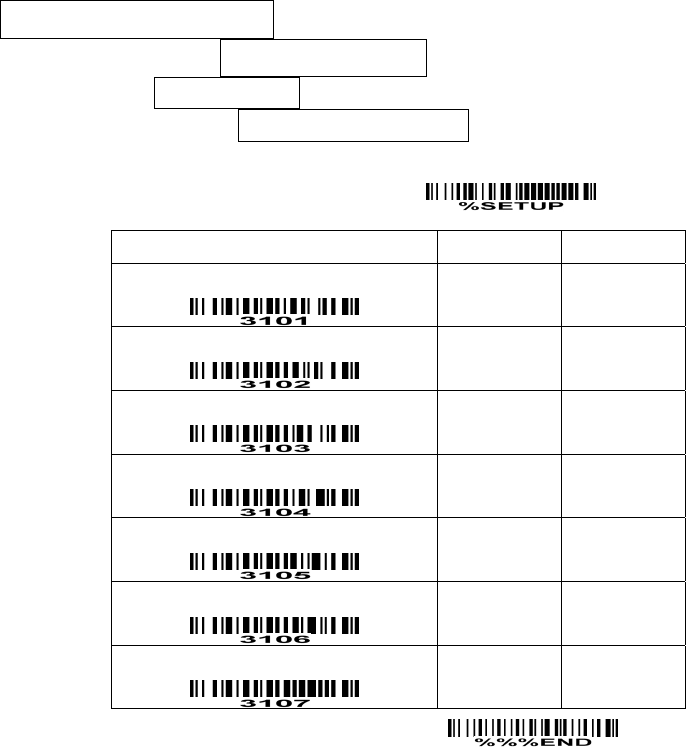
53
MicroPDF417
This decoder is only applied with a specified firmware.
Read:
Format
Data characters (variable)
Max. /Min. code length: Refer to Max./Min. code length of Code 39.
Code ID setting: Refer to Code ID setting of UPC-A.
Insertion group selection: Refer to Insertion group selection of UPC-A.
SETUP
Option bar code Option Alpha. entry
Read
Disable
Enable
00*
01
Max. code length
00-99
00-99
00*
Min. code length
00-99
00-99
01*
Code ID setting
00-FF16
(ASCII)
00-FF16
<P>*
Insert group selection
00-66
00-66
00*
Reserved
Reserved
END
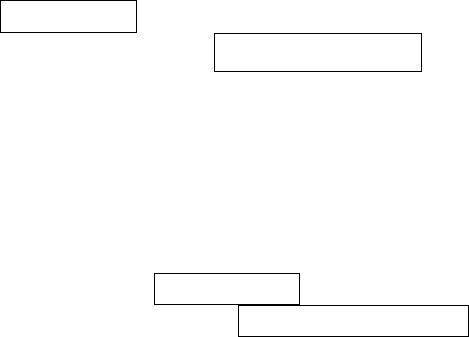
54
China Finance
Note: This type of barcode is not Omni-directionally decodable. The encodable character set includes
numeric 0 to 9. Among the symbol of 0 to 9, 0 and 2, 4 and 9, 5 and 8, 6 and 7, have the symmetrical
pattern; the pattern of 1 and 3 is symmetrical.
Read:
Format
10 Data digits
Max./Min. code length: Refer to Max./Min. code length of Code 39.
Check digit verification: The check digit is made as the sum module 10 of the numerical values of all data
digits.
Leading character 5/6/7/8/9 converted to A/B/C/D/E: By setting, leading character 5/6/7/8/9 can be
converted to A/B/C/D/E.
Leading character assignment: By setting, only the barcode with the assigned leading character can be
output.
Code ID setting: Refer to Code ID setting of UPC-A.
Insertion group selection: Refer to Insertion group selection of UPC-A.
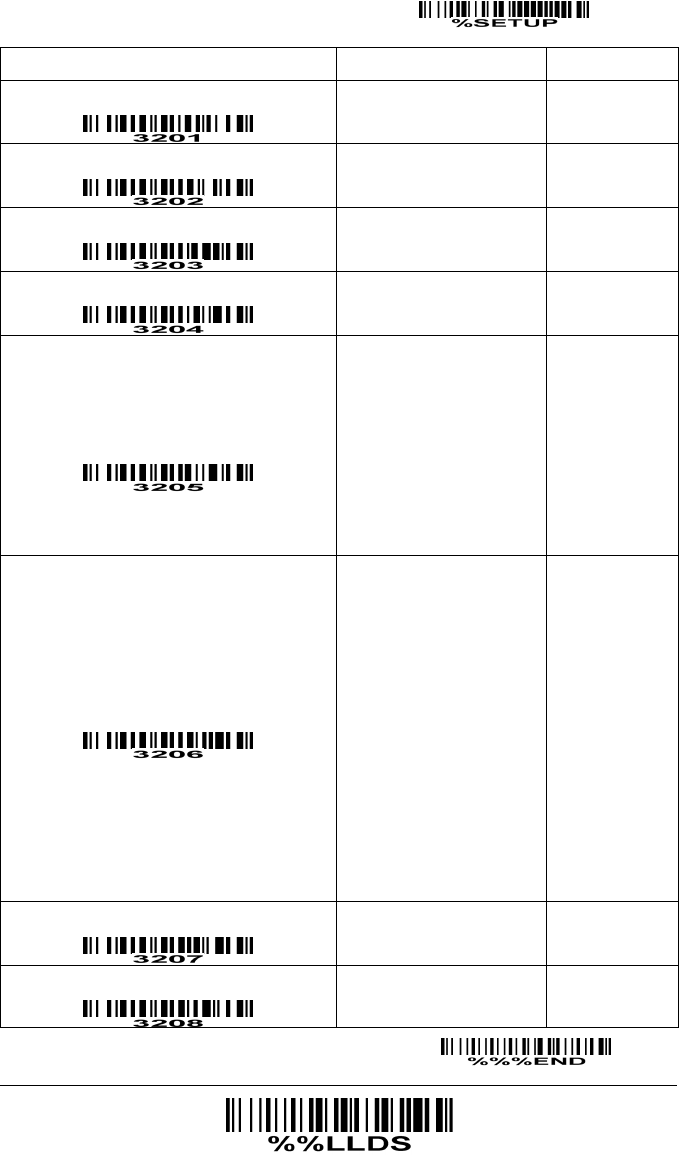
55
SETUP
Option bar code Option Alpha. entry
Read
Disable
Enable
00
01*
Max. code length
00-99
00-99
10*
Min. code length
00-99
00-99
10*
Check digit verification
Disable
Reserved
00*
01
Leading character 5/6/7/8/9
converted to A/B/C/D/E
Disable
Enable
Only 5 converted to A
Only 6 converted to B
Only 7 converted to C
Only 8 converted to D
Only 9 converted to E
00
01*
02
03
04
05
06
Leading character assignment
Disable
Assigned to 0
Assigned to 5(A)
Assigned to 6(B)
Assigned to 7(C)
Assigned to 8(D)
Assigned to 9(E)
Assigned to 1
Assigned to 2
Assigned to 3
Assigned to 4
00
01*
02
03
04
05
06
07
08
09
10
Code ID setting
00-FF16
(ASCII)
00-FF16
<Y>*
Insert group selection 00-66
00-66
00*
END
Laser Light Direction Setting: By scanning the barcode above, the
decoding direction of the scanner’s laser light is from left to right. By
scanning the up-side-down barcode above, the decoding direction of
the scanner’s laser light is from right to left.
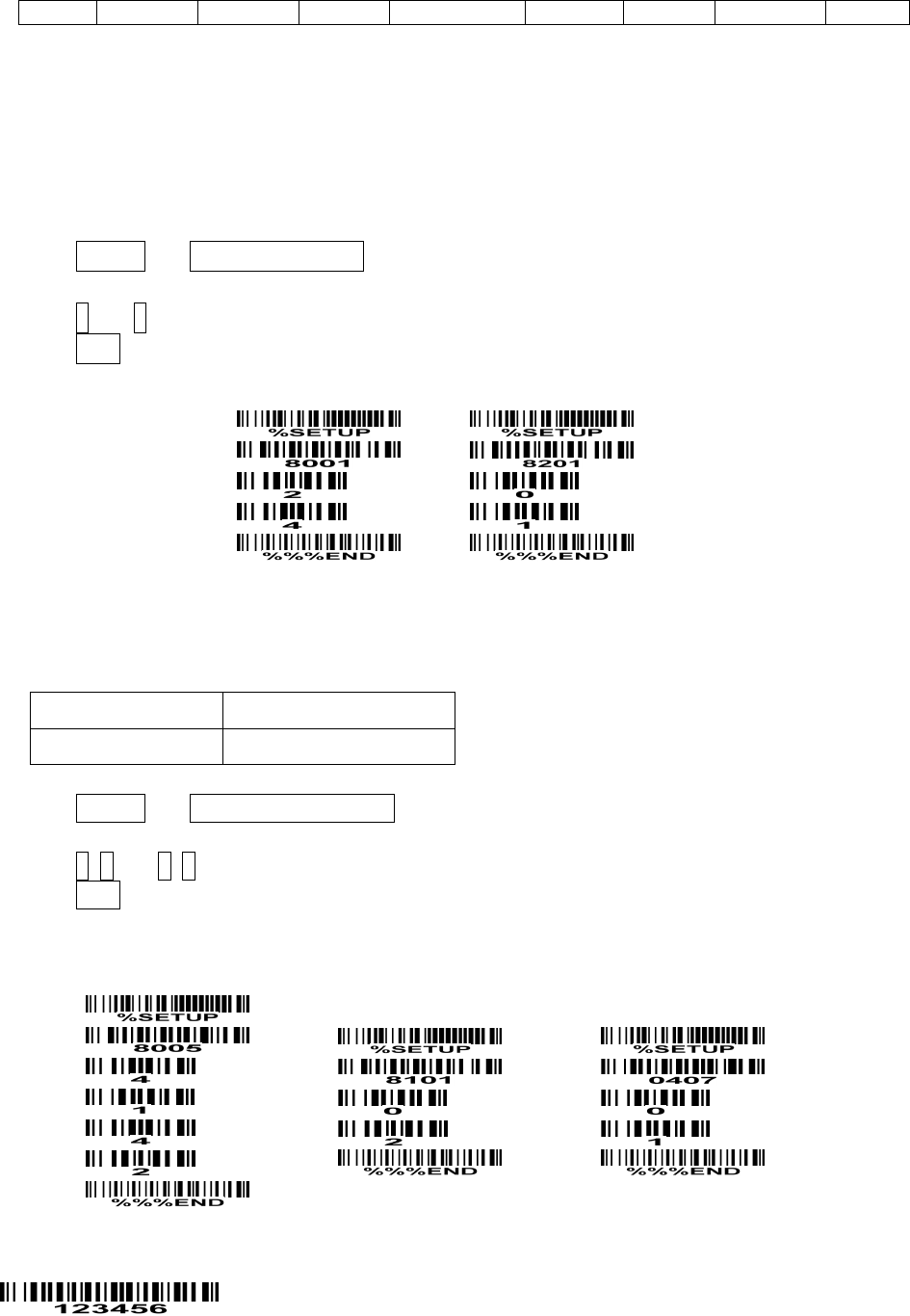
56
G1-G6 & FN1 substitution string setting
Format of barcode data transmission
Prefix Code name Preamble Code ID Code length Code data Code ID Postamble Suffix
Suffix string setting: The <enter > key is represented in different ASCII when it is applied by different OS.
For a Windows/DOS OS, <enter> is represented as <CR><LF> (0x0D 0x0A); for an APPLE MAC OS,
<enter> is represented as <CR> (0x0D); for a Linux/Unix OS, <enter> is represented as <LF> (0x0A).
Prefix/Suffix string setting: & Preamble/Postamble string setting:
They are appended to the data automatically when a barcode is decoded.
Example: Add a symbol of “$” as a prefix for all symbologies.
Steps:
1) Scan SETUP and Prefix string setting barcode.
2) Use the ASCII table to find the value of $→24.
3) Scan 2 and 4 from the barcode on the foldout back page.
4) Scan END barcode.
Scanning steps: Scan the following barcodes in order.
Insert G1/G2/G3/G4 string setting: The scanner offers 4 positions and 4 character strings to insert
among the symbol.
Example: Set G1 string to be “AB”.
Original code data “1 2 3 4 5 6”
Output code data “1 2 A B 3 4 5 6”
Steps:
1) Scan SETUP and Insert G1 string setting barcode “8005”.
2) Use the ASCII table to find the value of A→41, B→42.
3) Scan 4, 1 and 4, 2 from the barcode on the foldout back page.
4) Scan END barcode.
5) Refer to the chapter of G1-G4 string position & Code ID position.
6) Refer to the chapter of Hand-held scan & some global settings.
Testing barcode:
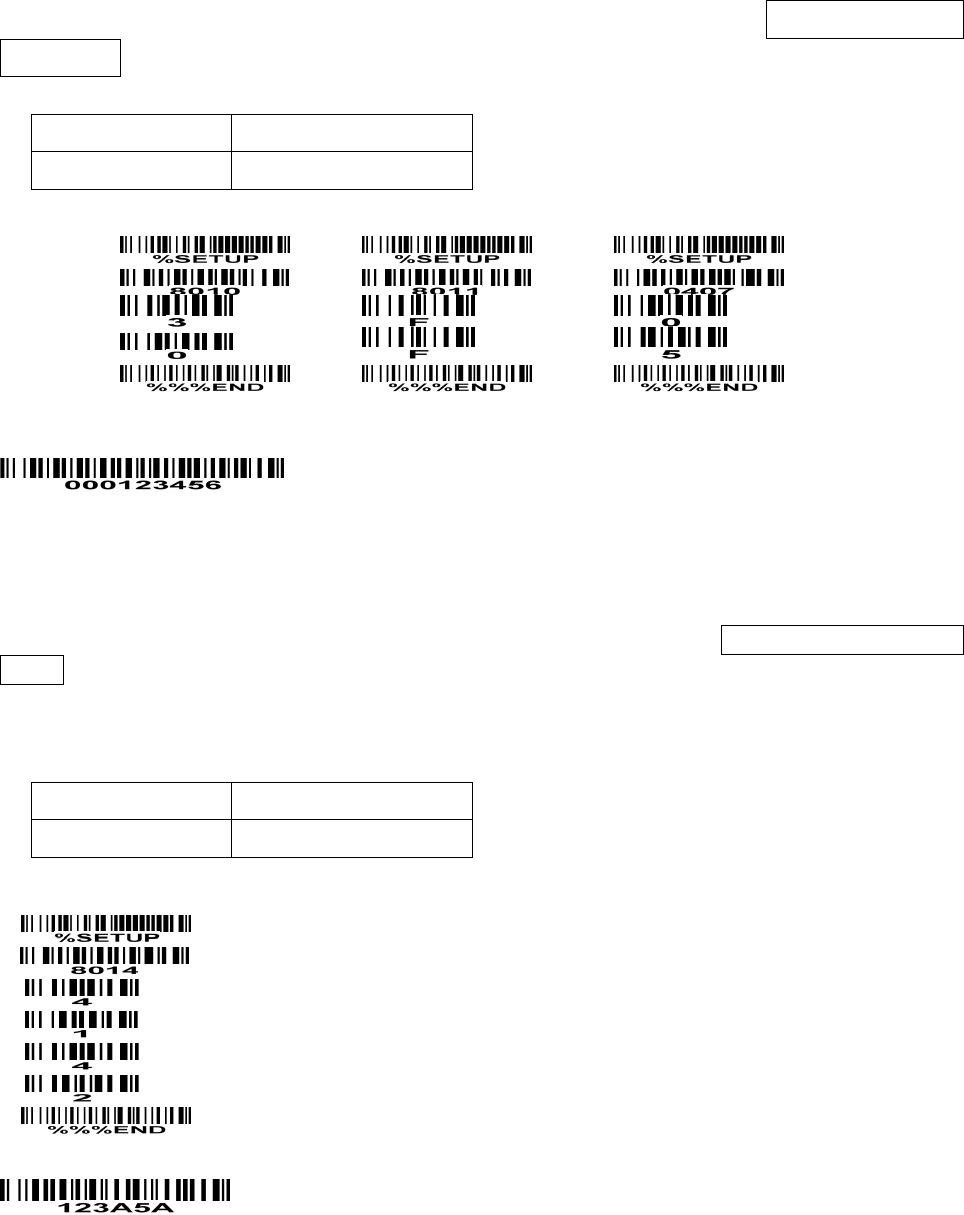
57
FN1 substitution string setting: The FN1 character (0x1D) in an UCC/EAN128 barcode, or a Code 128
barcode, or a GS1 DataBar barcode can be substituted with a defined string.
Truncate leading G5 string setting: By setting, a defined leading character or string can be truncated.
Also a single character can be un-defined.
Repeat of a G5 character setting: While G5 is set as a single defined/un-defined character, G5 can also
be set to be repeated. This setting is ignored when the truncate number is more than the barcode data
characters. The option of “FF” for this setting is not active while the option of Truncate leading G5
string setting is “00”.
Example: Truncate all leading zeros for all symbologies.
Original code data “0 0 0 1 2 3 4 5 6”
Output code data “1 2 3 4 5 6”
Steps: scan the following data in order.
Testing barcode:
Truncate ending G6 string setting: By setting, a defined ending character or string can be truncated.
Also a single character can be un-defined.
Repeat of a G6 character setting: While G5 is set as a single defined/un-defined character, G6 can also
be set to be repeated. This setting is ignored when the truncate number is more than the barcode data
characters. The option of “FF” for this setting is not active while the option of Truncate ending G6 string
setting is “00”.
Single character C1/C2 replacement: By setting, a defined character in the data string can be replaced
by another defined character. The C1 and C2 replacement are applied simultaneously.
Example: Replace all the “A” character in a data string to be “B” character.
Original code data “1 2 3 A 5 A”
Output code data “1 2 3 B 5 B”
Steps: scan the following barcodes in order. The ASCII value for “A” is 41, and the ASCII value for “B” is
42.
Testing barcode:
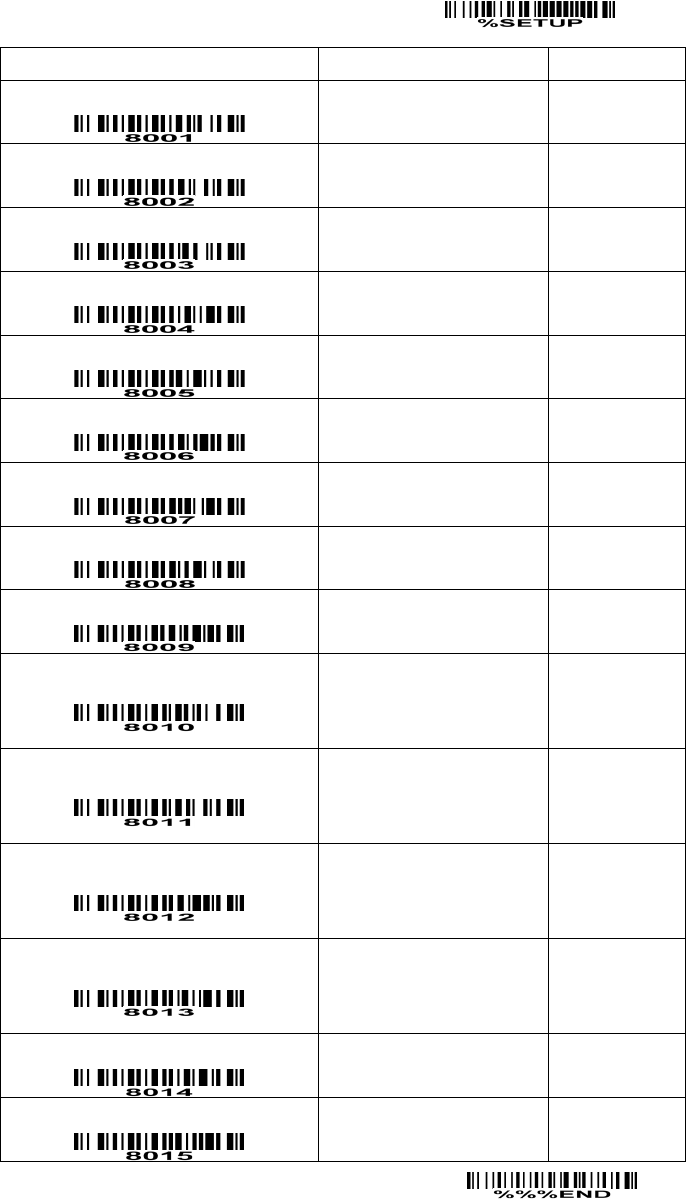
58
SETUP
Option bar code Option Alpha. entry
Prefix string setting
0-22 characters
None
00-FF16
00*
Suffix string setting
0-22 characters
<ENTER>
00-FF16
0A0D*
Preamble string setting
0-22 characters
None
00-FF16
00*
Postamble string setting
0-22 characters
None
00-FF16
00*
Insert G1 string setting
0-22 characters
None
00-FF16
00*
Insert G2 string setting
0-22 characters
None
00-FF16
00*
Insert G3 string setting
0-22 characters
None
00-FF16
00*
Insert G4 string setting
0-22 characters
None
00-FF16
00*
FN1 substitution string setting
0-4 characters
<SP>
00-FF16
20*
Truncate leading G5 string setting
A un-defined character
1-22 defined characters
<0>
00
01-7F16
30*
Repeat of a G5 character setting
Once
Defined times
Un-defined times (All)
01*
01-22
FF
Truncate ending G6 string setting
A un-defined character
1-22 defined characters
<0>
00
01-7F16
30*
Repeat of a G6 character setting
Once
Defined times
Un-defined times (All)
01*
01-22
FF
Single character C1 replacement
<0000> 0000*
0000-FFFF 16
Single character C2 replacement
<0000> 0000*
0000-FFFF 16
END
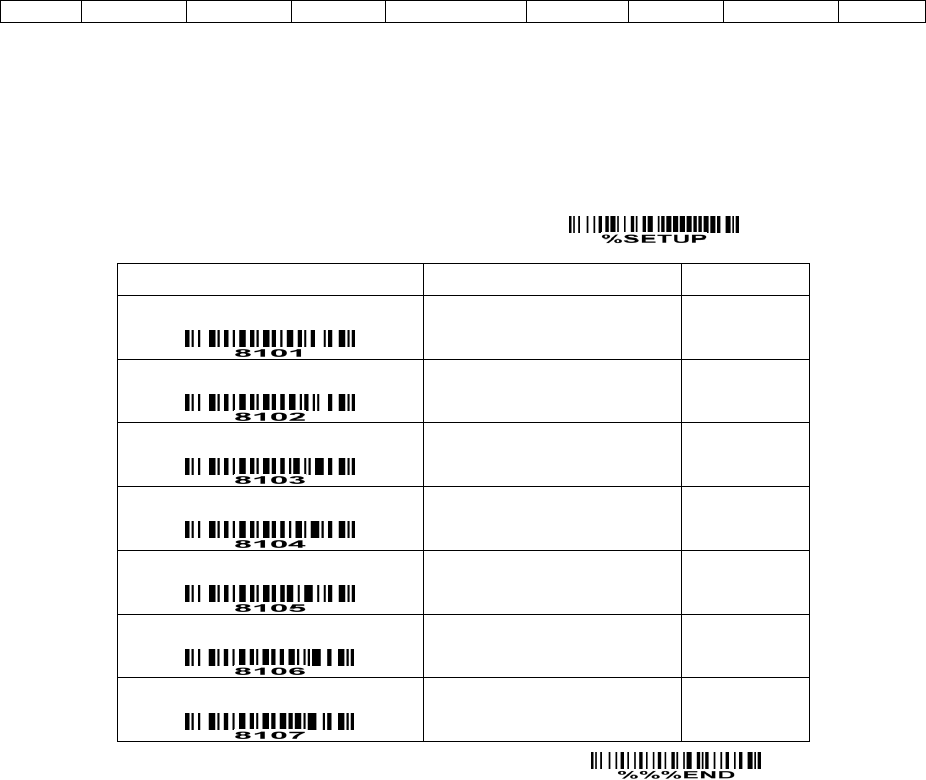
59
G1-G4 string position & Code ID position
Format of barcode data transmission
Prefix Code name Preamble Code ID Code length Code data Code ID Postamble Suffix
Insert G1/G2/G3/G4 string position: The scanner offers 4 positions to insert strings among the symbol.
In case of the insertion position is greater than the length of the symbol, the insertion of string is not
effective.
Code ID position: It is allowed to select different positions of code ID placement.
SETUP
Option bar code Option Alpha. entry
Insert G1 string position
00-99
00-99
00*
Insert G2 string position
00-99
00-99
00*
Insert G3 string position
00-99
00-99
00*
Insert G4 string position
00-99
00-99
00*
Code ID position
Before code data
After code data
00*
01
Reserved
Reserved
END
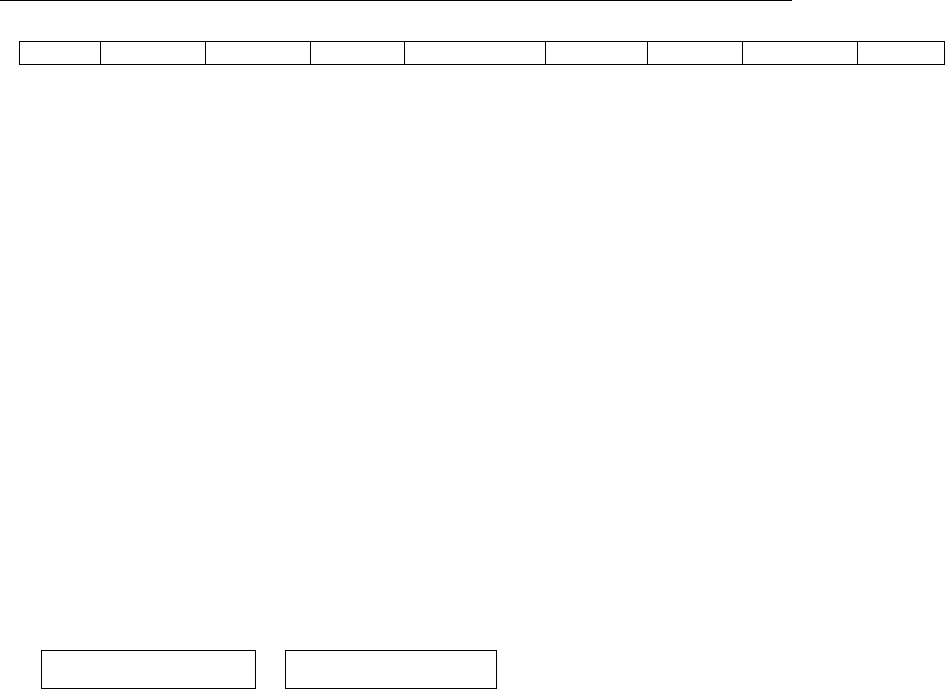
60
String transmission
Note: The information in this chapter is closely related to the chapter of String setting.
Format of barcode data transmission
Prefix Code name Preamble Code ID Code length Code data Code ID Postamble Suffix
Prefix transmission: By setting Enable, prefix will be appended before the data transmitted.
Suffix transmission: By setting Enable, suffix will be appended after the data is transmitted.
Code name transmission: By setting Enable, code name will be transmitted before code data.
Preamble transmission: By setting Enable, preamble will be appended before the data transmitted.
Postamble transmission: By setting Enable, postamble will be appended after the data is transmitted.
Code ID transmission: Code ID can be transmitted in the format of either Proprietary ID or AIM ID.
Refer to the chapter of Default setting for each barcode.
Code length transmission: The length of code data string can be transmitted before the code data when
Enable is selected. The length is represented by a number with two digits.
Case conversion: The characters within code data or the whole output string can be set in either upper
case or lower case.
FN1 substitution transmission: The scanner supports a FN1 substitution feature for keyboard wedge,
USB and RS-232 interface. The replacement string of FN1 can be chosen by user (see chapter of
G1-G6 & FN1 substitution string setting).
All-non-printable-character string transmission with string setting: By setting enable, all string settings,
e.g. Preamble transmission or Insert G1 string setting, are active for an all-non-printable-character string.
Here a non-printable character means a character with ASCII value between 0x00 to 0x1F.
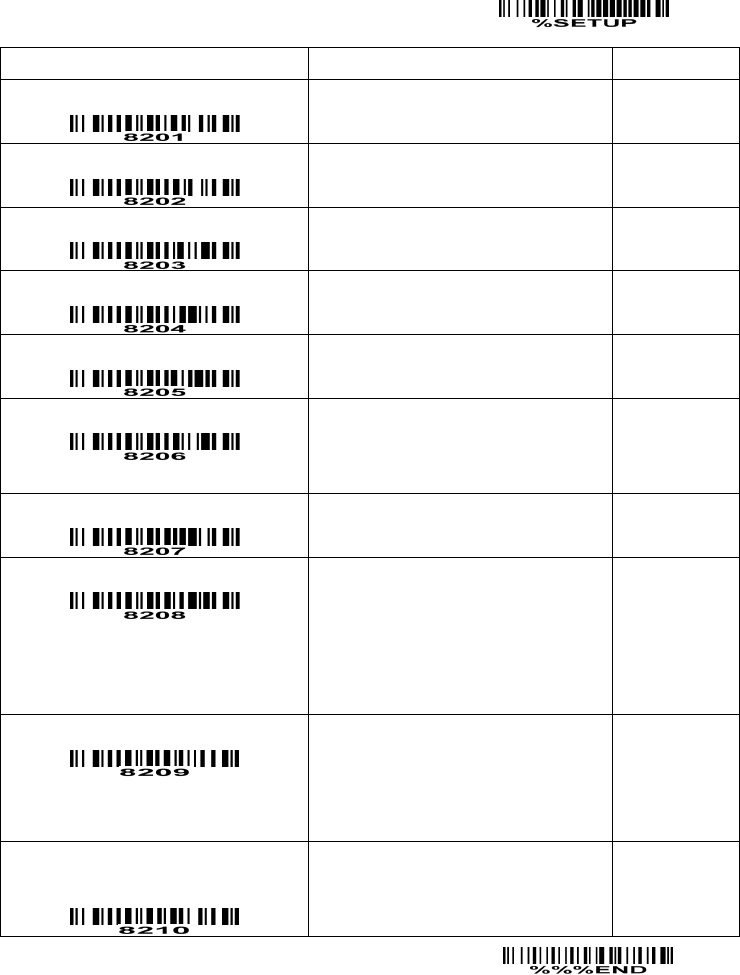
61
SETUP
Option bar code Option Alpha. entry
Prefix transmission
Disable
Enable
00*
01
Suffix transmission
Disable
Enable
00
01*
Code name transmission
Disable
Enable
00*
01
Preamble transmission
Disable
Enable
00*
01
Postamble transmission
Disable
Enable
00*
01
Code ID transmission
Disable
Proprietary ID
AIM ID
00*
01
02
Code length transmission
Disable
Enable
00*
01
Case conversion
Disable
Upper (data only)
Lower (data only)
Upper (whole string)
Lower (whole string)
00*
01
02
03
04
FN1 substitution transmission
Disable
Keyboard wedge/USB
RS-232
Keyboard wedge/USB/RS-232
00*
01
02
03
All-non-printable-character string
transmission with string setting
Disable
Enable
00*
01
END
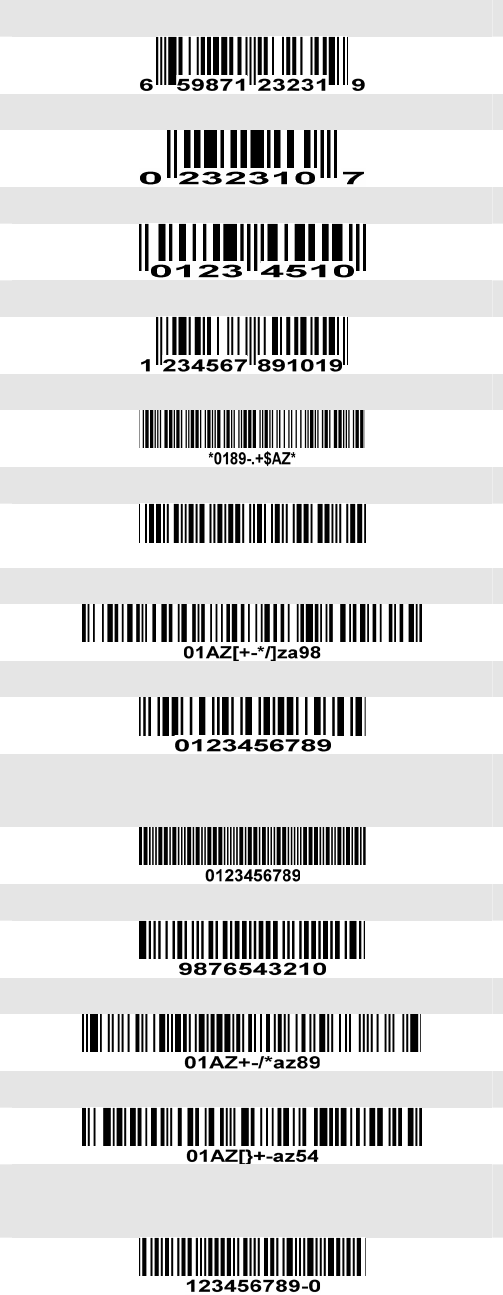
62
Test Chart
UPC-A
UPC-E
EAN-8
EAN-13
Code 39
Code 32
A908765439
Code 128
Interleaved 2 of 5
Industrial 2 of 5
(Default setting: Read disable)
Matrix 2 of 5
Code 93
UCC/EAN 128
Code 11
(Default setting: Read disable)
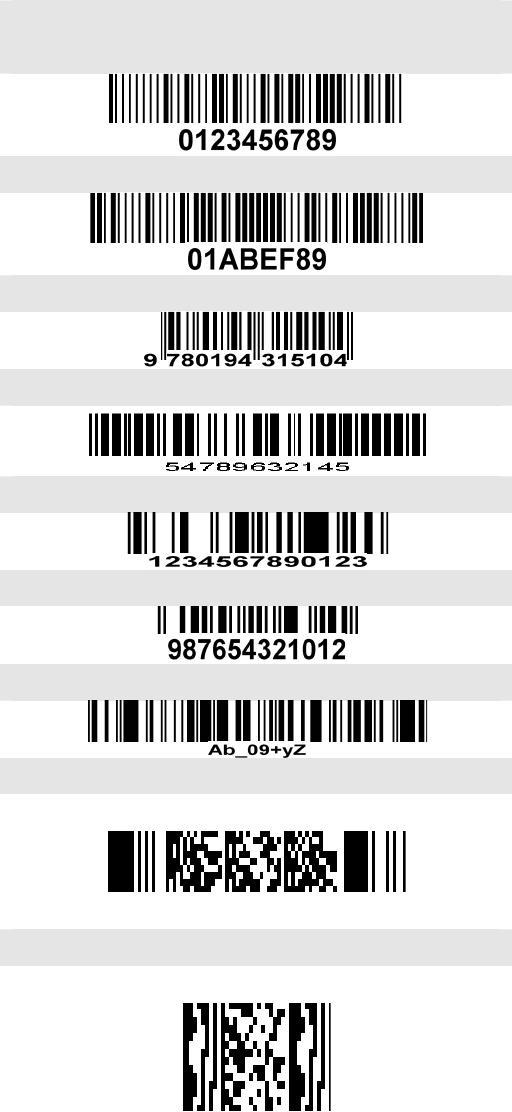
63
Test Chart (Continued)
MSI/Plessey
(Default setting: Read disable)
UK/Plessey
ISBN/ISSN
China Post
GS1 DataBar (GS1 DataBar Truncated)
GS1 DataBar Limited
GS1 DataBar Expanded
PDF417
01Az+-=
MicroPDF417
23+-mdo
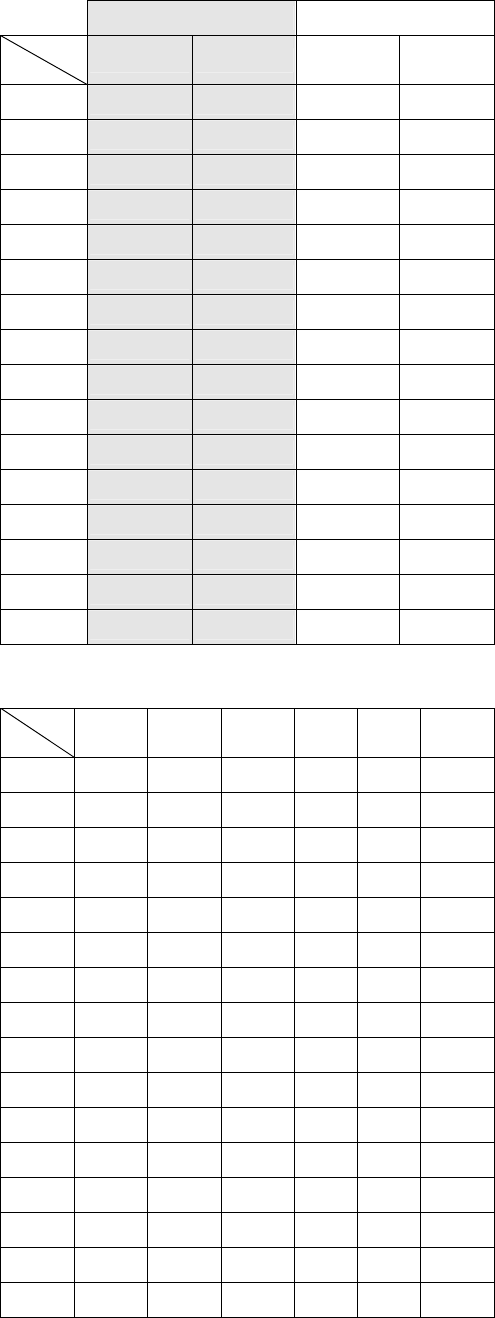
64
ASCII Table
for keyboard wedge for RS-232
H
L 0 1 0 1
0 Null NUL DLE
1 Up F1 SOH DC1
2 Down F2 STX DC2
3 Left F3 ETX DC3
4 Right F4 EOT DC4
5 PgUp F5 ENQ NAK
6 PgDn F6 ACK SYN
7 F7 BEL ETB
8 Bs F8 BS CAN
9 Tab F9 HT EM
A F10 LF SUB
B Home Esc VT ESC
C End F11 FF FS
D Enter F12 CR GS
E Insert Ctrl+ SO RS
F Delete Alt+ SI US
Notes: The 2nd and the 3rd columns above are used for keyboard wedge only.
H
L 2 3 4 5 6 7
0 SP 0 @ P ` p
1 ! 1 A Q a q
2 “ 2 B R b r
3 # 3 C S c s
4 $ 4 D T d t
5 % 5 E U e u
6 & 6 F V f v
7 ‘ 7 G W g w
8 ( 8 H X h x
9 ) 9 I Y i y
A * : J Z j z
B + ; K [ k {
C , < L \ l |
D - = M ] m }
E . > N ^ n ~
F / ? O _ o DEL
Example: ASCII “A” = “41”.
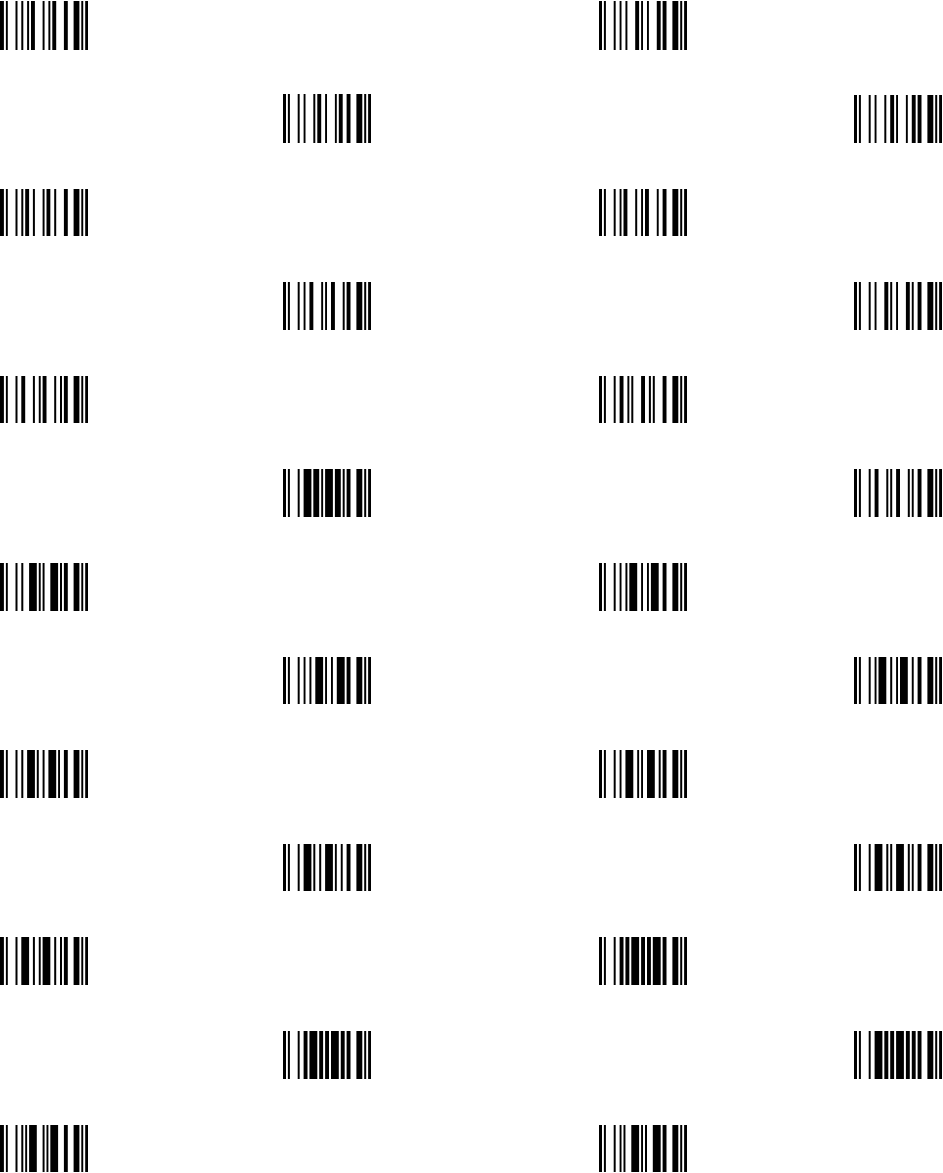
65
Barcode representing non-printable character
Notes to make the following barcode:
1. According to different barcode printing software, the method of printing following barcode is different.
2. If using CODESOFT software, firstly read the information through “Help→Index→Code128→Special input
syntax”. Also refer to ASCII table. For example, if we wish to make “F1” barcode, select “code128”, then
select “CODE A” type, and input “{DOC1}” as data.
Up ↑
Down ↓
Left ← Right →
Page Up
Page Down
Backspace Tab
Home
End
Enter Insert
Delete
F1
F2 F3
F4
F5
F6 F7
F8
F9
F10 Esc
F11
F12
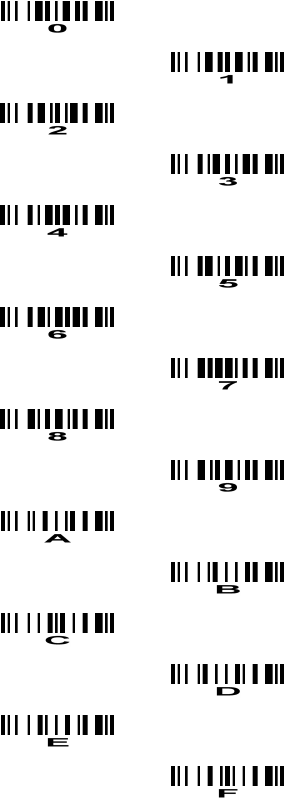
66
Configuration alphanumeric entry barcode
Federal Communications Commission (FCC) Interference Statement
This equipment has been tested and found to comply with the limits for a Class B
digital device, pursuant to Part 15 of the FCC Rules.
These limits are designed to provide reasonable protection against harmful
interference in a residential installation. This equipment generate, uses and can
radiate radio frequency energy and, if not installed and used in accordance with the
instructions, may cause harmful interference to radio communications.
However, there is no guarantee that interference will not occur in a particular
installation. If this equipment does cause harmful interference to radio or television
reception, which can be determined by turning the equipment off and on, the user is
encouraged to try to correct the interference by one of the following measures:
Reorient or relocate the receiving antenna.
Increase the separation between the equipment and receiver.
Connect the equipment into an outlet on a circuit different from that to which the
receiver is connected.
Consult the dealer or an experienced radio/TV technician for help.
This device complies with Part 15 of the FCC Rules. Operation is subject to the
following two conditions:
(1)This device may not cause harmful interference, and (2) this device must accept
any interference received, including interference that may cause undesired operation.
FCC Caution: Any changes or modifications not expressly approved by the party
responsible for compliance could void the user’s authority to operate this equipment.
RF exposure warning
This equipment complies with FCC radiation exposure limits set forth for an
uncontrolled environment.
The equipment must not be co-located or operating in conjunction with any other
antenna or transmitter.